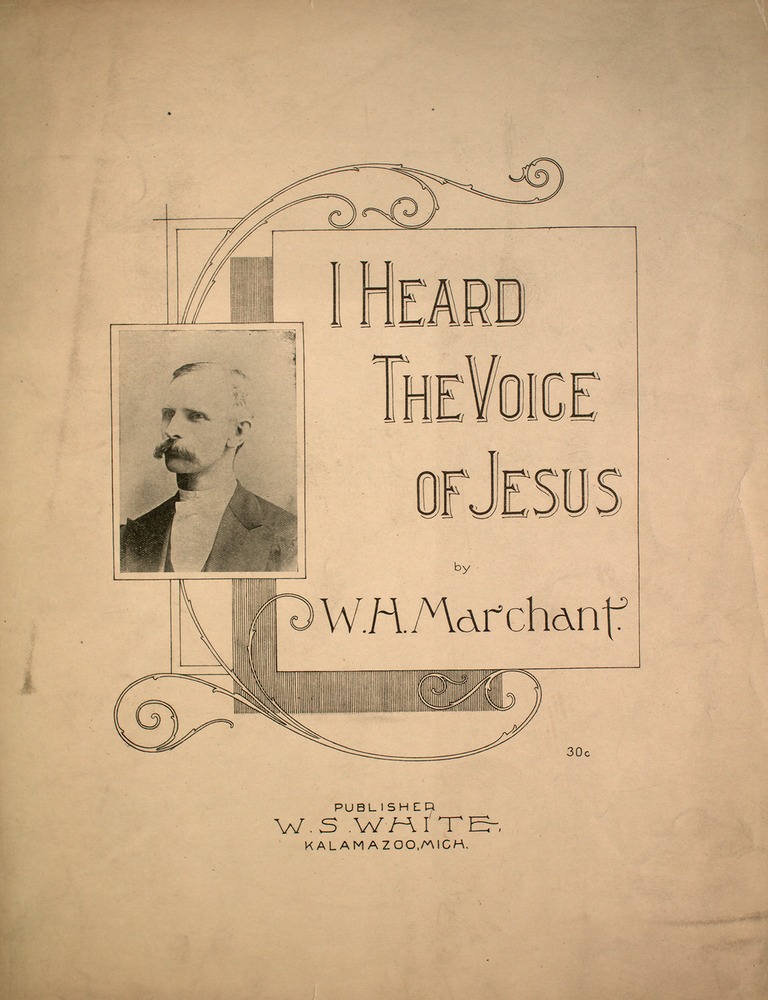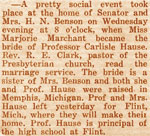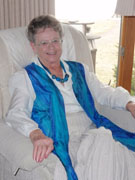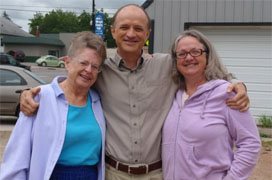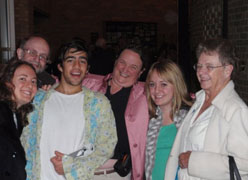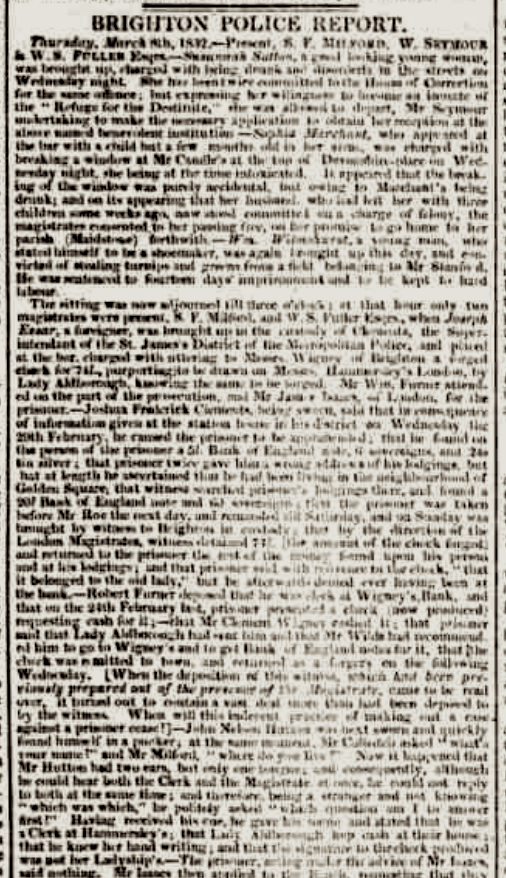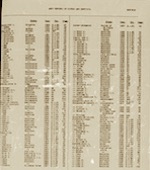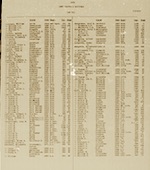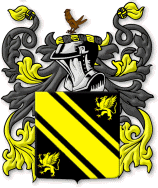 |
| Marchant |
|
"Marchant" is French, English and/or Scottish in origin. It's an occupational name for a buyer and seller of goods, from the Old French, Middle English term march(e)ant, and the Late Latin term mercatans, from Latin mercari (‘to trade’), and from merx (‘commerce’, ‘merchandise’, ‘exchange’). In the Middle Ages the term was used mainly to denote a wholesale dealer.
The Scottish branch of the family was first found in Buckinghamshire, where they were seated from early times and granted lands by King William for their assistance at the Battle of Hastings in 1066 A.D. The family Coat of Arms: Black with a bend between two gold griffins. The Crest is a Moor Cock. A British line hails from the Island of Guernsey, Channel Islands, including Peter Le Marchant (d. 1335), the Lieutenant Governor and Bailiff of the island of Guernsey early in the fourteenth century. (A French line of Marchants can be traced to Dauphiné, where the family has been seated since ancient times, and the line includes David LeMarchand who was a famous sculptor of ivory.)
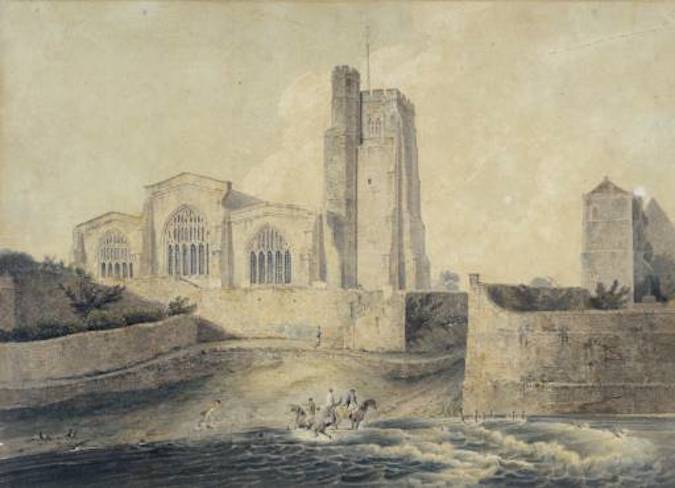
"All Saints Church, Maidstone," circa 1797. Joseph Mallord William Turner (1775-1851); watercolour on paper: 332 x 464 mm, Victoria and Albert Museum (London, UK). All Saints Church was the collegiate church of the College of All Saints, built in 1395 next to the Archbishop's Palace. In 1549, the college was dissolved and the church became the Parish Church of Maidstone. The first listing of the Marchant surname occurred with the marriage of Rebecca Marchant on 4 Dec 1598 (Canterbury Marriage Licences, First Series: 1568-1613 by Canterbury England Diocese; Edited by Joseph Meadows Cowper; Published by Cross & Jackman, Printers & Publishers, 6, High Street, Canterbury, 1892; p. 80). It is one of the largest and widest Parish Churches in England. The college, the church, the palace and the palace's tithe barn are all Grade I listed buildings. The church once had a far-reaching spire; unfortunately, the spire was struck by lightning in 1730 and was never rebuilt. Still, All-Saints is servicing the community today.
Modern images of All Saints Church on on the banks of the River Medway, at the junction of Mill Street, College Road and Knightrider Street. L-R: Church from the Medway (at night); Interior (Nave); Stone bench for worshippers who couldn't stand. (Aerial view—the background has changed!)
|
"At Maidstone the southern limit may be considered to have been reached of the district of Kent which can be distinguished as 'Dickens-land' in the most intimate sense, as lying within the radius of the novelist's habitual walks and drives from his residence at Gadshill."
—'Dickens-Land,' described by John Arnold Nicklin; Published by London : Blackie, 1911.
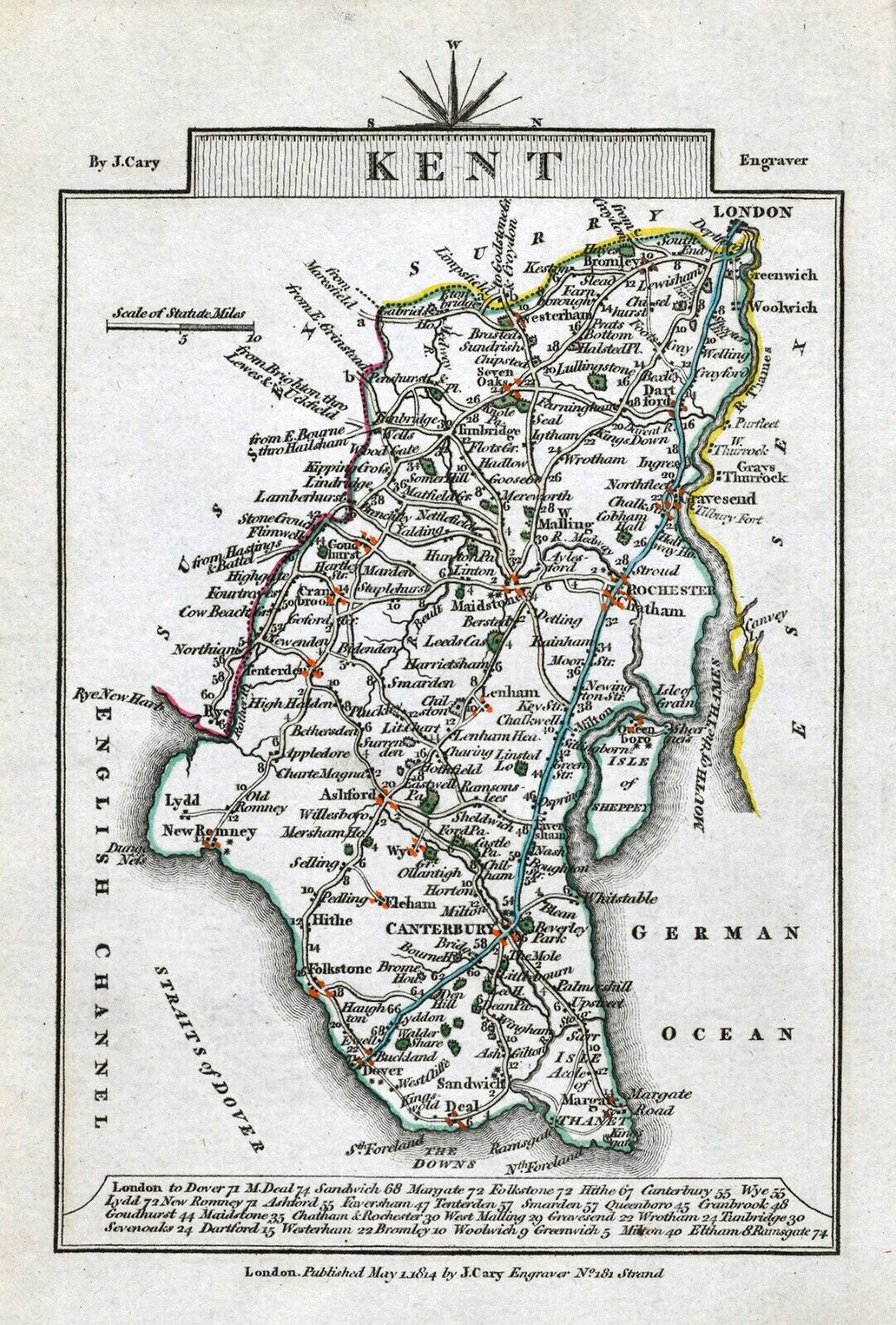
Road Map of Kent, published in Cary's Traveller's Companion or, A Delineation of the Turnpike Roads of England and Wales, published by John Cary in London, 1814. (Click to enlarge.) |
Our particular family lineage can be traced back to an Englishman named JOHN MARCHANT, who was born around 1767 and possibly was baptized to a THOMAS MARCHANT and mother MARY (PRICE?) on 4 Nov 1770 at All Saints Parish in Maidstone, a town in the county of Kent, 32 miles south-east of London, England.
Maidstone stands on the river Medway, at the influx of the Len. The river carried much of the town's trade as the center of the agricultural county of Kent, known as the Garden of England, and several wharves along the river could transport corn, hops, fodder, fruit, stone and timber during the 1700s. With evidence of settlement in the area dating back before the Stone Age, Maidstone is said to have been the third largest city of the ancient Britons, who called the city Medwag or Megwad, from the name of the river. It was known to the Romans as Ad Madam, also from the name of the river, which the Romans called Madus. By the Middle Ages, the main exports in the area seemed to be fatal diseases: Between 1384 and 1668 there were 24 outbreaks of plague listed in the town history, as well as six outbreaks of smallpox in the 18th Century. Maidstone was poor and insurgent at the time of John's birth, and the government was corrupt. The committee that oversaw the city tried to restrict voting, until Lord Mansfield remarked in court that the Mayor and Jurates of Maidstone "would overturn the Constitution itself, if it were in their power."

| Due to chronic shortages of coins produced by the British Crown during the 18th and early 19th Centuries, many private mints were opened throughout England, producing "Conder Tokens." This one is a 1795 Maidstone Halfpenny, featuring the Shield of the Arms of Maidstone. It was issued for general circulation in a mintage of 15,500, and manufactured by William Lutwyche (Roger Dixon, diesinker). |
|
|
| Personal Information |
Census Image |
|
| Name: |
|
John Marchant |
| Age: |
|
84 |
| Where born: |
|
Maidstone, Kent |
| Residence Note: |
|
Bone Alley |
| District: |
|
Maidstone |
| Occupation: |
|
Lath Render |
|
|
|
|
SOURCE INFORMATION: 1851 England Census. Class: HO107; Piece: 1617; Folio: 20; Page: 10; GSU roll: 193518.
|
|
John worked as a "lath render" (also called a "lath cleaver," "lath splitter," or "lath river"). In 19th Century England, A lath render's sole occupation was to split wood, making thin strips, called "laths," from the timber. The laths were used in the building trade to form lattice-work, or for blinds or shutters. Fir trees were used for making laths: the trunks were split in half, and the heart wood taken out. The sapwood was sliced along the grain, giving strength and elasticity to the lath. There were two types of lath renders: one a standing render, the other a sitting render. The sitting render was the older version, using a bench with pegs to hold the wood in place. The standing render used a small axe, sharpened on two edges. The sitting render used a riving knife. The riving tools were made by local blacksmiths. (The occupation died out with modern inventions like plasterboard, which made the job much easier and specialists were no longer needed—making for a lot of unemployed Marchants in the latter 19th Century.)
John married a woman named SARAH (REYNOLDS?) on 31 May 1789, at All Saints Parish (FHL Film #1736877; Reference ID: Bk1/DCB/BT1/152/786). They had at least 10 children, among them several sons who John taught the same trade. Their children were:
CHILDREN OF JOHN AND SARAH MARCHANT |
| SARAH MARCHANT was born in 1791 in Maidstone, Kent, England. A Sarah Marchant was baptized on 27 Feb 1791 at All Saints, Maidstone, Kent (FHL Film Number: 1736877). No further information. |
| JOHN MARCHANT was born in Jun 1793 in Maidstone, Kent, England. He joined the army in 1812 and was in the 52nd Foot Soldiers, 2nd Battalion according to a muster roll on 5 May 1812, but he deserted in late 1813. Another muster has him in the military from 25 Mar 1815 to 24 Jun 1815 in the Maidstone Depot unit (Piece Number 12809). |
| THOMAS MARCHANT was born in 1795 in Maidstone, Kent, England. An infant named Thomas was baptized to John and Sarah Marchant on 16 Aug 1795 in Maidstone, Kent, England (FHL Film Number: 1736877). No further information. |
| GEORGE MARCHANT was born in Sep 1797 and baptized on 24 Sep 1797 in Maidstone, Kent, England (FHL Film Number: 1736877). The Kent Weekly Chronicle of 19 Jan 1821 reports that a George Marchant was in court for stealing 8 rabbits in Lewes (a few miles from Maidstone). In an advert from the South Eastern Gazette placed by George when he returned to Maidstone, it appears he took over the lath-rending business in the area after the death of his father. In another ad he calls himself "The Cheapest House for Laths." George later became the tavern keeper of the Huntsman beerhouse. The Maidstone Journal and Kentish Advertiser of Monday 13 June 1870 reported: "Inquest.—The borough coroner held an inquest this (Monday) morning upon the body of George Marchant, aged 73, a lath splitter and beershop keeper, living in Astley Street, who was found dead early on Saturday morning, having strangled himself with rope he was in the habit of using to lift himself up in the bed with. A verdict of temporary insanity was returned." |
| CHARLOTTE MARCHANT was born in 1799 in Maidstone, Kent, England. She was baptized on 10 Nov 1799 at All Saints Parish (FHL Film Number: 1736877). She died in 1802 and was buried on 30 Nov 1802 in Maidstone (FHL Film Number: 1736877; Reference ID: BK1/DCB/BT1/152/961). |
| MARY ANN MARCHANT was born in 1802 in Maidstone, Kent, England and was baptized on 4 Apr 1802 (FHL Film Number: 1736877). On 3 Jul 1822 she married James Lemon at All Saints, Maidstone, Kent, England. In the 1851 census she is living in Maidstone with James (who is working as a bargeman), and her father, lath render John Marchant. By the 1861 census she is living as a boarder without James. She was buried on 31 Jan 1865 in Maidstone, Kent, England (FHL Film #1835479; Reference ID Roll 194 P R356). |
| ROBERT MARCHANT was born on 29 Dec 1803 in Maidstone, Kent, England and also became a lath render. He married SOPHIA JONES. Family listed below. After Sophia passed in the Maidstone workhouse in 1839, Robert would marry another three times in the 1840s-1860s. He died in the Lambeth workhouse in 1884. |
| CHARLOTTE MARCHANT (2) was born in 1806 in Maidstone, Kent, England, and was baptized on 3 Aug 1806 at All Saints Parish (FHL Film Number: 1736877). No further information. |
| WILLIAM MARCHANT was baptized on 21 Feb 1813 in Maidstone, Kent, England (SOURCE: England, Births and Christenings, 1538-1975. Salt Lake City, Utah: FamilySearch, 2013. FHL Film Number: 1835447; Reference ID: item 2 p8). William also became a lath render, and he was very close with brother Robert. They lived near each other in Deptford (SE London). A "William Marchant, CofE," entered the Lambeth workhouse on 21 Jul 1873, and was a lath render from 34 Irston Street. A Sarah Marchant (William's wife) died in Greenwich (included Deptford) in 1872, so he may have come to Lambeth to be near his brother. William left the workhouse on 4 Nov 1873, and records show that a William Marchant died in Southwark soon after, in 1874. |
| JANE MARCHANT was born in 1814 in Maidstone, Kent, England and baptized on 27 Dec 1814 in Maidstone (FHL Film Number: 1835447). No further information. |
.gif) |
| Jones |
|
Maidstone is considered 'Dickens Land,' named after the greatest writer and social critic of the Victorian era, Charles Dickens (1812-1870), who lived in the area at roughly the same time as the next generation of our Marchant family. It could be said that our next ancestor, ROBERT MARCHANT, could have been a character in a Dickens novel, as both a hero and as a villain. Robert was born on 29 Dec 1803, and became a lath render, like his father and his brothers. He married SOPHIA JONES on 27 Nov 1825 at All Saints in Maidstone.¹
The "Jones" surname in England is patronymic from the Middle English personal name Jon(e). The surname is especially common in southern central England, and first found in Lincolnshire, borne by Alanus filius Jene in 1275. The family's Coat of Arms was a silver shield with through black cornish choughs. The Crest features two battle axes in saltire proper.

 |
| Ferrell |
|
Sophia's father was JOHN JONES, who married MARY FERRELL on 30 Jun 1788 at Herstmonceux. The surname of Ferrell was first found in Leinster, where they were found mainly in County Longford. The Family Motto is Cu reabtha (rampaging dog).
John and Mary had Sophia baptized on 14 Feb 1807 in Salehurst, a village in East Sussex; A son, Henry George, was baptized in nearby Bodiam on 24 Nov 1811. Sophia had at least two other siblings, as well: Mary had given birth to Sophia's half-sister, Eleanor, out of wedlock and she was baptised on 29 Feb 1784 in Salehurst (this daughter married a William Bryant in Rolvenden on 9 Apr 1809 and they settled there). Another sister was Rosannah (1801-1842), who would become very important to our line of the family; Her age in 1841 is given as 40, but that may well have been rounded down so she was born c.1796-1801. ("John Jones" and "Mary" is a common combination in Sussex records, so Elijah Jones (Mayfield, 1793), John Jones (Framfield, 1788), Mary Ann Jones (Fletching, 1797), John Jones (Horsham, 1806), and John Jones (Hastings, 1810)—all with parents named John and Mary Jones—could also be siblings.)
As lath rending work became more scarce during the 19th Century, Robert and his family had to tramp (i.e., walk long distances across the countryside) while Robert searched for jobs, and sometimes even new occupations. Over the course of his life he would be listed as a lath render, a lather renderer (a worker who covered the laths with a plaster concoction of lime and horse hair on walls & ceilings), a general laborer, a pedlar, and a hawker (crier) in various places around Kent and Sussex counties. Consequently, Robert and Sophia had children born in the towns of Maidstone, Northiam, Rochester, and Hurstpierpoint. Their children were:
CHILDREN OF ROBERT MARCHANT AND SOPHIA JONES |
|
ROBERT MARCHANT was born on 10 Jan 1826, and was baptized at St Margaret's, Rochester, on Feb 19th. On 30 Mar 1855 he married (1) Sarah Anna Greenwood (1835-1866) and they had the following children: Maria Anna (1856-1862), Joseph Thomas (1859-1859, William Henry (1860-1861), Robert (1862-1862), Margaret Ann (1863-1869), and Sophia (1865-1866). None of the children lived into adulthood. When Sarah passed away in 1866, Robert remarried to (2) Elizabeth Lambert (1841-1891) in St Vincent de Paul, Lancashire on 14 Oct 1866 (click on the church record, at right). They had the following children: Robert Joseph (1867-1940), Mary (1869-1954), George (b. 1870), Henry Stephen (b. 1872), Thomas (b. 1876), Elizabeth Marchant (b. 1882). In the 1901 England census, he is a widower living with daughter Mary (1869-1954) and her husband, Michael Henry Sarsfield (1867-1938). Robert died in Apr 1909 in Liverpool, Lancashire, United Kingdom. See a genealogy of his descendants here.
|
|
WILLIAM MARCHANT was born on 8 Jun 1828, and christened on 29 June 1828 at Northiam, Sussex. He joined the Royal Canadian Rifles and married MARTHA LOUISA READ (1832-1886). Family listed below. After the death of his wife, he returned to England. In the 1891 census of England, he is living with his brother Robert in Liverpool. He's a widower and his death certificate from 16 Dec 1896 quotes his occupation as an army pensioner. He is buried in the Church of England section of Anfield Cemetery in Liverpool (238 Priory Road, Anfield, Merseyside England, Postal Code: L4 2SL)."
|
|
HENRY MARCHANT (1) was baptized on 19 Feb 1830 at All Saints, Maidstone, Kent, England to Robert and Sophia Marchant. (England, Births and Christenings, 1538-1975. Salt Lake City, Utah: FamilySearch, 2013; FHL Film Number: 1835448; Reference ID: p 154, 1229.) He died as an infant. From the Sussex Advertiser on Monday, 12 April 1830, page 3, column 4: "On Wednesday, at Crowborough Gate, on view of the body of Henry Marchant, an infant about ten weeks old. The mother was on her way from Brighton to Maidstone with the deceased, and upon her arrival at the gate at Crowborough, discovered the child to be dead. It has always been in a very unhealthy state. Verdict—Died by the visitation of God." Burial Date: 12 Apr 1830 at All Saints, Maidstone, Kent, England (England Deaths and Burials, 1538-1991. FHL Film Number 1835448, p 228, 1820.)
|
|
MARY ANN MARCHANT was baptized on 07 Aug 1831 in Hurstpierpoint, Sussex, England to Robert and Sophia Marchant. (England, Births and Christenings, 1538-1975. Salt Lake City, Utah: FamilySearch, 2013; FHL Film Number: 416747) She also traveled to Canada, like her brother William, and settled in St. Catharine's. She married GEORGE BARR (b. 1831) of Scotland Village on 10 Sep 1861 in Lincoln, Ontario. "Sept. 10: George Barr, Private in H. M. Royal Canadian Rifle Regiment, and Mary Anne Marchant, both of St. Catharines; witnesses: Mary Illsey, Charles Illsey, Corpl. R. C. R.; by Thomas T. Robarts." (SOURCE: St. George's Parish Church, St. Catharines, Jubilee celebration and historic and centenary review, by Robert Ker, St. Catharines, Ont.: Star Print. 1892. p. 133) She and George (Barr) came back to Scotland where he was born and he became a spirits merchant. They're on the 1871 and 1881 censuses. He died 1887. She died in 1895 from cirrhosis of the liver.
|
|
ELIZABETH MARCHANT was baptized on 12 May 1837 in Maidstone, Kent, England to Robert and Sophia Marchant. (England, Births and Christenings, 1538-1975. Salt Lake City, Utah: FamilySearch, 2013; FHL Film Number: 1835449) She died in 1841. ("England and Wales, Death Registration Index, 1837-1920", Volume 5, page 222, line 14. Elizabeth Marchant: Oct-Nov-Dec 1841; Maidstone, Kent, England.) Records for Maidstone Union (which cover the period 1835 to 1841) show Elizabeth Marchant born on 21 April 1837 to Sophia Marchant (Legitimate) and Baptised on 12 May 1837. The Burial Register shows Elizabeth Marchant buried on 22 November 1841, when four years old in Linton, a village and civil parish in the Maidstone District of Kent.
|
 |
HENRY MARCHANT (2) was baptized on 12 May 1837 in Maidstone, Kent, England to Robert and Sophia Marchant (England, Births and Christenings, 1538-1975. Salt Lake City, Utah: FamilySearch, 2013; FHL Film Number: 1835449; Reference ID: 1 64 506), He was baptized at same time as Elizabeth, but there's no evidence that they are twins. A Henry Marchant aged 7 is in the workhouse in 1841. Henry survived the workhouse and became a cordwainer/shoemaker. He married Mary Jane Brailsford Holness in 1857 and they had 4 children: Eliza, Mary Ann, Henry and Elizabeth. Henry Jr., died as an infant in 1861 and Mary Jane (wife/mother) died soon after the birth of Elizabeth in 1862. They lived with Mary Jane's parents in Dover and Eliza and Mary are still there in 1871. Elizabeth was then with a great uncle and aunt nearby. Henry seems to have disappeared. When Eliza married in 1876 her marriage certificate says Henry is deceased. There is a newspaper report of the sudden death of a shoemaker named Henry Marchant in Reading (Berkshire) in 1869. He was buried in consecrated ground (like William) in London Road Cemetery, Wokingham on 29 Sep 1869 (Berkshire Burial Records). See a genealogy of his descendants here.
|
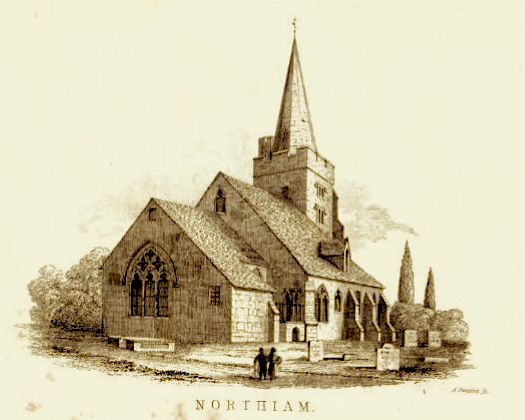
"Northiam Church" by Arthur Hussey, from "Notes on the Churches in the Counties of Kent, Sussex, and Surrey," 1852. (St. Mary) |
Robert and Sophia's second son, WILLIAM MARCHANT, was born on 8 Jun 1828 and christened on 29 June 1828 at Northiam, a civil parish within historic Sussex (now in the Rother District of the administrative county of East Sussex).² The parish record of the baptism shows the date of the event, the names of the parents and, interestingly, Robert's trade as a "Pedlar" (peddler—a person who goes from place to place selling small goods). Then, on daughter Mary Ann's baptismal record, Robert's described as a "Hawker" (the words, hawker, pedlar, crier and costermonger were used interchangeably, but they all meant, technically speaking, a traveling peddler who would bang a drum or ring a bell in the street, and call out what he had for sale). Types of pedlars included "feather men" who cleaned bedding made of feathers, "cat-meat men" who fed the felines, and "rag and bone men" who scavenged unwanted items such as rags, bones, metal and other unwanted items, then sold them to local traders and shops (they were some of the first recyclers). Whatever the wares or services that Robert was selling, it had to be a hard, itinerant lifestyle for Sophia and three small children to accompany him on.
|
Images of St. Mary Church, Church Lane, Northiam TN31 6NN England. L-R: Church; Heraldic Shields; Victorian-era Grotesque on on Frewen chapel. (Plus, here's a gargoyle!)
|
| Personal Information |
Baptism |
| Name: |
|
William
Marchant |
| Date of Baptism: |
|
29 Jun 1828 |
| Place: |
|
Northiam, Sussex, England |
| Gender: |
|
Male |
| Father's Name: |
|
Robert Marchant |
| Mother's Name: |
|
Sophia Marchant |
|
|
|
|
|
SOURCE INFORMATION: "England, Sussex, Parish Registers, 1538-1910", database, FamilySearch, William Marchant, 1828. GS Film #001894275; Digital Folder #004426949; Image #00420
|
The village of Northiam where William was baptized is located thirteen miles north of Hastings in the valley of the River Rother, and 24 miles from Maidstone, Kent. The parish church of St Mary was created out of an old Norman structure, with much 14th-century rebuilding, and a stone spire replacing the original Norman tower in the late 15th century. Northiam was a known meeting place for Romanies/Gypsies, so it was a good area for Robert to hawk his wares.
Although William was christened in Northiam, and despite the fact that his family would spend much time in Sussex county over the next several years, he would always call Maidstone his "hometown" in later life—probably because it's where his parents were married, and it's where he spent most of his childhood... although many of his memories would not be pleasant.
"Sophia Marchant, wife of Robert Marchant who hath ran away from and deserted her and her three children, namely Robert aged about six years William aged about four years and Mary Ann aged about eight months, have come to inhabit the said Parish of Saint Michael in Lewes."
—Removal order from Lewes St Michael, Sussex, to the parish of Maidstone, Kent; 10 Apr 1832 (East Sussex Records Office).
| Trial Information |
Criminal Register |
| Name: |
|
Robert
Marchant |
| Date of Trial: |
|
Lent |
| Trial Year: |
|
1832 |
| Location: |
|
Sussex, England |
| Crime: |
|
Larceny |
| Sentence: |
|
6 months |
| Date of Execution or Release: |
|
Imprisonment |
|
|
|
|
|
SOURCE INFORMATION: Criminal Registers, Middlesex and Home Office: England and Wales; Records created or inherited by the Home Office, Ministry of Home Security, and related bodies, Series HO 26 and HO 27; The National Archives of the UK (TNA), Kew, Surrey, England.
|
The marriage of Robert and Sophia Marchant appears to have been a rocky, difficult one, but it is difficult 200 years later to know or understand the environment and circumstances that this family had to overcome. They were extremely poor, and spent large amounts of time apart. By the early 1830s the court record shows that Robert had left Sophia and their three children (Robert, William and Mary Ann; Henry, born after William, was discovered to have died at ten months old at the Crowborough Gate in Sussex, while Sophia was returning to Maidstone from Brighton, 65 miles away). Sophia and the remaining children were on their own in Sussex, when on 10 Apr 1832 authorities in the parish of St. Michael in Lewes decreed that Robert "ran away from and deserted" Sophia, and ordered that Sophia and the three children should be sent back to Maidstone.
The police report suggests that Sophia had some means of living in the area and was probably in touch with relatives before moving on to Lewes where Robert was serving time. The family travelled extensively around Sussex, so connections with families (using mixed spellings) such as Jones (the family of Sophia's father), Ferrell (the family of Sophia's mother), Bryant (the family of her half-sister), Brazil, Coney etc., keep cropping up. Branches of Jones and Ferrells were carpenters and builders—and this was railway building boom time—so there was still work available for lath renders in the area (or a chance for hawkers to woo new crowds of strangers—or for those with a more larcenous bent to take advantage of them).
Although Robert was not with the family, he may not have actually deserted Sophia. A 28-year-old Robert Marchant was serving "six months to hard labor" in the town's jail for the crime of stealing two pounds of pork, according to the Sussex Advertiser of Monday 26 March 1832. This Robert Marchant was "sent down" at Lewes Assizes in March 1832 (Lewes was the county town of Sussex), and Sophia was ordered back to Maidstone from the same town a month later, in April.

"Maidstone High Street from Gabriel's Hill" (1829), by George Sidney Shepherd (1784-1862), Maidstone Museum & Art Gallery. A vibrant town hub since 1261, High Street links Maidstone to the River Medway and runs through the very heart of the town. It still exists today (foot traffic only). |
| Article Information |
Newspaper |
| Newspaper: |
|
Maidstone Gazette and Kentish Courier |
| Date: |
|
Tuesday 21 February 1837 |
| Page: |
|
4 |
| Column: |
|
3 |
| Title: |
|
Maidstone Police |
| Date of incident: |
|
11 Feb 1837 |
|
|
|
|
|
SOURCE INFORMATION: The British Library, 96 Euston Rd, London NW1 2DB; Maidstone Gazette and Kentish Courier for Kent, Sussex, Surry, and Essex, #2029; Publisher: Maidstone: R.J. Cutbush.
|
With Robert either gone or in jail, there were no new Marchant children for several years. Sophia left the area again to stay near her father in the seaside town of Hastings in East Sussex County, but it didn't provide a stable home for the family; on 16 Oct 1833, two Justices of the Peace of the parish of St. Clement of the town and port of Hastings ordered her back to Maidstone, in order to avoid being a charge on their own parish. Whether this was actually the town running the family out or just a cheap strategy for Sophia to travel home with the children is unknown.
While the family struggled to find a stable home, Robert continued to run afoul of the law, as he and his brother William were fined in 1837 for a fight outside a pub in Maidstone, in which they attacked a police officer trying to arrest one of their friends for deserting from the army, and then helped the deserter to escape.
Where Sophia and the children ended up during this time, is a very sad story.
| Personal Information |
Removal Order |
| Name: |
|
Sophia
Marchant |
| Spouse: |
|
Robert
Marchant |
| Children: |
|
Robert (6) William (4), Mary (8 mos.) |
| Date: |
|
10 Apr 1832 |
| Parish: |
|
St Michael |
| Town: |
|
Lewes |
| County: |
|
Sussex |
| ESRO: |
|
414/32/2/89 |
|
|
|
| Personal Information |
Removal Order |
| Name: |
|
Sophia Marchant |
| Spouse: |
|
Robert Marchant |
| Children: |
|
Robert (7)
William (5)
Mary Ann (2) |
| Date: |
|
16 Oct 1833 |
| Parish: |
|
St. Clement |
| Town: |
|
Hastings |
| County: |
|
Sussex |
| ESRO: |
|
367/32/2/165 |
|
|
|
|
|
SOURCE: East Sussex Records Office/The Keep, Woollards Way, Brighton, East Sussex BN1 9BP; Phone: 01273 482349. National Archives: Lewes / Hastings.
|
"No wonder that the lower classes dread the very name of the Poor Law,—no wonder that they look upon the Union house as worse than a prison, and that in fact many rather than become the inmates of a workhouse, commit some petty felony that they may obtain, to them, a far lighter punishment—incarceration in a gaol (jail)!"
—"Extracts from the Diary of a Workhouse Chaplain," by the Rev. D. L. Cousins, A.M. London: J. Hatchard and Son, 1847.
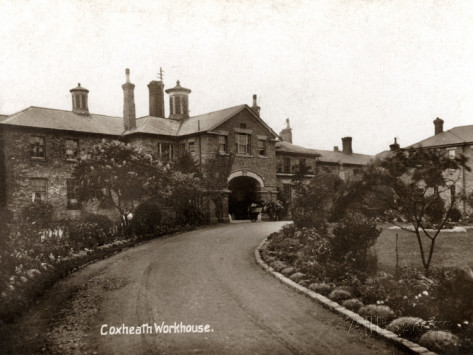
"Coxheath Poor Law Union" Workhouse site (renamed Maidstone Union Workhouse in 1836), from the north-east, c.1905. © Peter Higginbotham. |
In 19th-Century England, parishes were legally responsible for looking after their own poor. This was funded by the collection of a poor-rate tax from local property owners. Workouses were then created to provide work for the unemployed able-bodied (with the threat of prison for those who refused). They also provided housing for orphans and the "impotent poor" (the elderly, chronic sick, etc.) The Marchant family would eventually qualify for all of those categories.
Maidstone was the location of the "workhouse" where Sophia and the children were sent. The Maidstone Union Workhouse was built in 1836 at a site to the south of Heath Road in Coxheath "for 600 paupers." The design was of plain brick construction and comprised a large quadrangle enclosed by two-story buildings. A further building, thought to be the workhouse school, were erected nearby at the north side of Heath Road. The dormitory blocks, which were referred to as 'cottages' measured 15 feet by 10 feet, lit by a small window. There was a single ground-floor privy on each side of the courtyard.
Workhouses looked like prisons from the outside, and life inside them was miserable—and intentionally so. The government, terrified of encouraging 'idlers' (lazy people), made sure that people feared the workhouse and would do anything to keep out of it—including stealing pork and risking imprisonment, like Robert.
Here is what our ancestor William Marchant, a child under ten years of age, faced in the workhouse:
LIFE IN THE WORKHOUSE |
|
Upon entering the workhouse, the Marchant family would have been immediately separated, and Sophia would only have been allowed limited contact with her children—perhaps for an hour or so a week on Sunday afternoon. William and his siblings had to rely on each other to survive.
William's clothes were removed and stored. He was searched, his hair was cropped, and he was bathed (under supervision). Supervised baths were then given once per week.
He was made to wear a uniform, so that every inmate looked the same, and everyone outside knew he was poor and lived in the workhouse. William was given a striped shirt, ill-fitting trousers (the length being adjusted at the knee with a piece of string), thick vest, woollen drawers and socks, a neckerchief and (in winter) a coarse jacket. Sophia and the girls were given a shapeless, waistless dress which reached the ankles, made of striped (convict-style) fabric, a shapeless shift, long stockings and knee-length drawers, and a poke-bonnet. All the inmates were given hob-nailed boots.
Women, children and men had different living and working areas in the workhouse. Married couples, even the elderly, were to be kept apart at all costs so that they could not 'breed'. They could be punished if they even tried to speak to one another.
Although the workhouse was required to provide free education and job training for William, the education he actually received would not have included reading and writing—which were the two most important skills needed to get a good job.
The food in his meals was tasteless, and they rarely changed. Commonly, the meal would have been gruel, which is a thin food made by boiling oatmeal or some other grain in water. Other base ingredients to boil could include breadcrumbs or ground crackers. Often the quantity, quality and lack of nutrition meant that workhouse inmates were on a slow starvation diet.
William's 'work' would have consisted of stone-breaking, bone-crushing, sack-making, driving the corn mill, or picking apart "oakum" (old ropes), sometimes tarred or knotted. These ropes had to be unpicked inch by inch and a day's work would be to unravel 3 lbs. of rope. The corn mill was driven by inmates walking round on a treadwheel. (Women had to do domestic work: scrubbing floors and tables, polishing brasses, black-leading kitchen ranges, and so on.)
William could also find himself 'hired out' to work in factories or mines.
|
"I had no advice, no counsel, no encouragement, no consolation, no assistance, no support, of any kind, from anyone, that I can call to mind, as I hope to go to heaven!"
—'David Copperfield,' by Charles Dickens.
|
| Personal Information |
Death Record |
|
| Name: |
|
Sophia Marchant |
| Year: |
|
1839 |
| District: |
|
Maidstone |
| County: |
|
Kent |
| Volume: |
|
5 |
| Page: |
|
213 |
|
|
|
|
SOURCE INFORMATION: General Register Office. England and Wales Civil Registration Indexes. London, England: General Register Office.
|
|
Despite their rocky relationship and forced separation in the workhouse, Robert and Sophia were out of Maidstone Union long enough to have two more children, Henry (b. 1834) and Elizabeth (1837-1841). But Robert never found steady work, and they always seemed to end up back in the workhouse. Life was hard for everybody—the average life span of people around London at this time was 27 years, but for members of the working class, that number dropped to 22. In the workouse, however, life itself was seen as a burden on society, and as a result the buildings were filled with misery, rampant disease, and death, from which the Marchant family would not be spared: William's mother became ill in 1839, while in the workhouse. She would have been housed separately in a sick-ward, with no visitors allowed, including William and the other children. The workhouse sick-ward took in all cases, so at any one time there may have been patients suffering from any variety of complaints ranging from broken legs, measles, typhoid fever and smallpox to blindness, scarlet fever, diphtheria and dysentery. It was the worst place for a sick person to be.
Sophia Jones Marchant passed away in October of 1839 in the Maidstone workhouse, leaving five children between the ages of two and 12 to fend for themselves.⁴ Her sister Rosanna Balcomb, a widow, had been sent back with Sophia to Maidstone from Sussex, and it's likely that she kept an eye on Sophia's children in the workhouse until her own death in Maidstone, in June of 1842.
| Article Information |
Newspaper |
| Newspaper: |
|
Maidstone Gazette and Kentish Advertiser |
| Date: |
|
Tuesday 03 December 1839 |
| Page: |
|
4 |
| Column: |
|
3 |
| Title: |
|
Police |
| Date of sentencing: |
|
30 Nov 1839 |
|
|
|
|
|
SOURCE INFORMATION: The British Library, 96 Euston Rd, London NW1 2DB; Maidstone Gazette and Kentish Advertiser for Kent, Sussex, Surry, and Essex, #2801 (full page).
|
Robert Sr. wasn't around to watch over the children. In fact, the Maidstone Journal and Kentish Advertiser of Tuesday 3 Dec 1839 reported that a Robert Marchant was convicted of deserting his wife and family, and sentenced to three months imprisonment in the house of correction. While we can't be sure if this particular Robert is our ancestor, we do know that Robert soon left Kent and moved to Surrey—where there was more work, and where his brother was already living, in the London borough of Lambeth.
Robert's estrangement from his family also didn't dissuade him from starting new ones: Robert would marry another three times in the 1840s-1860s. In the 1841 census he is living in Brixton, Surrey, with a woman named Ann Hadly (b. abt. 1806 in St Mary Warsh, Wiltshire, England). By 1851, she is Ann Marchant and they live on Brandon Street (although they're in the census and voter lists for Surrey). Robert eventually ended up back in the workhouse, at Lambeth.
| Personal Information |
Census Image |
| Name: |
|
Robert
Marchant |
| Est. Birth Year: |
|
1806 |
| Civil Parish: |
|
St Mary Newington |
| Hundred: |
|
Brixton |
| County/Island: |
|
Surrey |
| Sub-Registration District: |
|
St Peters |
| Borough: |
|
Lambeth |
|
|
|
| Personal Information |
Census Image |
| Name: |
|
Robert Marchant |
| Est. Birth Year: |
|
1803 |
| Where Born: |
|
Maidstone, Kent |
| Civil Parish: |
|
Newington |
| County/Island: |
|
Surrey |
| Sub-Registration District: |
|
St Mary |
| Borough: |
|
Lambeth |
|
|
|
|
|
SOURCE INFORMATION: 1841 England Census. Class: HO107; Piece: 1064; Book: 3; Civil Parish: St Mary Newington; County: Surrey; Enumeration District: 5; Folio: 13; Page: 19; Line: 3; GSU roll: 474657; 1851 Census: Class: HO107; Piece: 1568; Folio: 391; Page: 19; GSU roll: 174802.
|
|
| Personal Information |
Census Image |
|
| Name: |
|
William Marchant |
| Age: |
|
12 |
| Where born: |
|
Kent, England |
| Civil Parish: |
|
Linton |
| Hundred: |
|
Maidstone |
| County: |
|
Kent |
|
|
|
|
SOURCE INFORMATION: 1841 England Census. Class: HO107; Piece: 459; Book: 23; Civil Parish: Linton; County: Kent; Enumeration District: Maidstone Union Workhouse; Folio: 25 (Robert Jr. on 27); Page: 2; Line: 1; GSU roll: 306853.
|
|
With their father out of the area, and their mother deceased, the prospects for the Marchant children were obviously not bright in Maidstone. It was a brutal time to grow up in England, as poverty and disease were rampant. During the 1830s, nearly half of the funerals in London were held for children under the age of 10. Many died from contagious disease and malnutrition. If that wasn't enough, they were practically orphans, stuck in a workhouse right out of Oliver Twist, with no prospects.
In the 1841 census, William appears with siblings Robert (on a separate page here), Mary, Henry and Elizabeth, with aunt Roseanne Balcomb in Coxheath Workhouse in Linton, a village and civil parish in the Maidstone District. It can be surmised that the Marchant children were in the care of Roseanne—but she would have been separated from the children in the workhouse, just like Sophia had been—and the family began to disintegrate even more. One daughter, Elizabeth, died in 1841 in the Union Workhouse in Linton, at the age of four, and was buried there (Strays from Maidstone, Kent). The others had to grow up fast: the eldest son, Robert Jr., joined the merchant navy (family historians Paul Harrington and Julie Callanan are fairly certain he first went to sea in 1837, when he was just 11). Meanwhile, William may have briefly worked for a shoemaker outside of the workhouse. He would later cite it as his occupation on his army record, and his uncle was a shoemaker (brother Henry became a cordwainer/shoemaker, too—it was not unusual at this time for children of 6 or 7 to have full-time jobs). The trade was taught in the workhouse, and the shoemaker was a valued position on the staff list, just after the governor, the nurses and the teacher.
But William's life would completely change when, as a 14-year-old boy, he enlisted in the army in Rochester, possibly by arrangement through the parish of Maidstone.¹⁰ Something in his story must have touched his recruiters, because they offered him a position in a division that was reserved strictly for veterans, with the promise of land and a new start in a far-off country. William joined the Royal Canadian Rifle Regiment as a bugler in Feb 1842, to start a new, stable, and (hopefully) happier life:
The Royal Canadian Rifle Regiment |
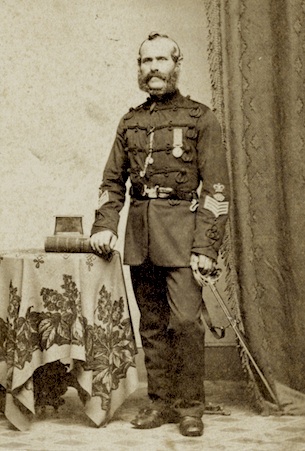
Sgt. William Marchant. Black and white photo on a white card, which has a gold line edging (10cm by 6.1Cm). Written on the back in blue: "Marchant Bandmaster." Hand printed on the reverse in pencil: "c. 1870 Marchant ... Sgt. Marchant—was band sergeant of RCRR—then joined the Oxford Rifles." (Photo courtesy of Woodstock Museum National Historic Site.) |
The Royal Canadian Rifle Regiment (usually abbreviated as "RCRR") was a British Army regiment that was mostly made up of long-serving soldiers. British military pensioners with good records, and who had served a minimum of 15 years in a British regiment qualified for service in the Royal Canadian Rifles. The uniform was green with scarlet facings, so the nickname for the corps was the "bullfrogs." While the nickname wasn't prestigious, there were perks for the recruits, including bounties, a higher rate of pay, and the opportunity for twice as many wives to live in garrison "on the establishment"—that is to say, entitled to live in barracks and receive regular rations. Most importantly, they were promised preferential treatment in acquiring cheap Canadian land at the time of the their retirement
William Marchant, however, enlisted as a 14-year-old—he or the army fudged his age—to become a bugler. Marchant family genealogist Paul Harrington writes: "My first researches suggested that only veteran soldiers were recruited for the RCRR and that William may have joined them later when in the Canadian colonies. I've seen discharge papers showing soldiers joining the RCRR after leaving other regiments but it seems William was always in the RCRR. He'd have been recruited as a boy bugler (as a virtual orphan from the workhouse a life in Canada may have seemed exciting—assuming he had some choice in the matter) and I have found army records for the RCRR detailing the pay for boys recruited under the age of fifteen."⁴ He got to this new paradise just in time to hear of the ill-fated Franklin Expedition to the Canadian Arctic, which left England in 1845, in which the shipwrecked crew tried to travel across the frozen tundra on foot, ending in starvation, death and cannibalism.
The RCRR's head quarters was established in Toronto in 1840, where they cleaned up the remnants of the "Upper Canada Rebellion" and oversaw the union of Upper and Lower Canada into the Province of Canada. Regimental head quarters moved to Kingston in 1855. Individual companies of the Regiment were detached and deployed at various garrisons throughout Canada West (Ontario) and Canada East (Quebec). One company was stationed at Fort Wellington throughout the 1840s and 1850s. The RCRR was disbanded at Kingston on 30 September, 1870 as one of the final acts before the British Army withdrew from Canada after Confederation.
William Marchant rose to Bugle Major and served more than 23 years in North America, then was discharged from the RCRR in May 1866 at Kingston, to settle in St. Catherine's. (The 1861 military census for Kingston has William Marchant listed as a soldier with the Royal Canadian Rifles.) He left the army on pension on July 3rd 1866. Below are military records for William Marchant in the Royal Canadian Rifles. (The National Archives of the UK; Kew, Surrey, England; Royal Hospital Chelsea Pensioner Registers & Service Records, 1760-1882; Class: WO 97; Piece: 1708. Crown Copyright images reproduced courtesy of The National Archives, London, England.)
|
But Canada wasn't the most stable place to live, either. Even when the United States wasn't threatening to invade, the French were threatening to leave. It all started in the late 1700s, when the British army had seized the French colony of Quebec. In 1791 the Brits chopped Quebec in half, making one colony into two: Upper Canada for the English, and Lower Canada for the French. Then in 1841 London passed the Act of Union, and Upper Canada and Lower Canada were merged into one United Province of Canada, governed by a proper parliamentary system—with the system was rigged to ensure the more conservative English always held the majority of seats. The French were not happy about this, and rebellions popped up all over the country. The British military was brought in to keep the peace and eventually settle with their own families, further strengthening the British presence.
William started as a private in the RCRR on 25 Feb 1842, and was made bugler on 1 Feb 1843. Living in a new country, on a new continent, with a small but reliable military salary—and a chance for advancement out of his humble beginnings—William began to build a stable life for himself.
On 7 Aug 1847 in St Catharine's, 19-year-old William married 15-year-old MARTHA LOUISA READ (19 June 1832 - 7 Apr 1886), who had been born in Ontario.⁵ Not much is known about Martha's early life, but she was probably the daughter of THOMAS READ (1786-1839), originally of Lincolnshire, England, and his wife MARTHA SIMPSON (b. 1799). Thomas was a servant to a captain in His Majesty's 76th Regiment of Foot.
William and Martha raised a family in Ontario, offering them a stable, secure home that he had never experienced as a child. The children of William and Martha Marchant were:
CHILDREN OF WILLIAM MARCHANT AND MARTHA LOUISA READ |
| ROSANNE LOUISA MARCHANT was born on 30 Sep 1848. She died on 2 Dec 1849, at age 1 year, 2 months, 2 days. |
|
WILLIAM HENRY MARCHANT was born on 26 December 1850 in Ontario. He was a private in the 26th Regiment, Middlesex Light Infantry in 1880. (Source: Library and Archives Canada; Ottawa, Ontario, Canada; Department of Militia and Defence, Accounts and Pay Branch, Nominal Rolls and Paylists for the Volunter Militia, 1855-1914; Record Group Number: R180-100-9-E; Volume Number: 77.) He married MARTHA HOLLAND (1852-1911) and they had three children: Fredie (1872-1873), Lillie (1878-1942) and Marjorie (1892-1939). They moved to Michigan in the United States, where William died on 9 March, 1896, age 45 years, 5 months, in Kalamazoo. He is buried at Ingersoll Rural Cemetery in Ingersoll, Oxford County Municipality, Ontario, Canada: Section A, Lot 92 (Ingersoll Rural Cemetery Burial Register: 1886-1908, page 50). Click on the photo, at right, to see Professor William Henry Marchant's funeral wreath in Ingersoll.¹¹
|
| LOUISA JANE MARCHANT was born on 20 Mar 1853. She died on 30 Nov 1853, age 8 months, 10 days. |
| JULIA ANN MARCHANT was born on 26 Sep 1854. She died on 29 Oct 1855, at age 1 year, 1 month, 3 days. |
|
ROBERT JAMES MARCHANT was born on 10 Sep 1856 in Toronto, Ontario. He worked as a printer and did some military duty, as the Nominal Rolls for the 22nd Battalion have a R Marchant for 1872. He died from acute hepatitis and chronic inflammation of the lungs at the age of 29 years and ten months, in Ingersoll (click on death record at right). A notice dated 3 Aug 1886 stated that his funeral was held on August 5 at his father's residence on King Street East (see a display from the funeral by clicking on the image at right). Robert was buried at Ingersoll Rural Cemetery,⁶ : Section A, Lot 92 (Ingersoll Rural Cemetery Burial Register: 1864-1886, page 34).
|
|
MARTHA LOUISE MARCHANT was born on 13 Jan 1859 in Toronto, Ontario. She died on 7 Apr 1872, age 13 years, 2 months, 24 days. (Image at right: Archives of Ontario. Registrations of Deaths, 1869-1938. MS 935, reels 1-615. Archives of Ontario, Toronto, Ontario, Canada; Series: MS935; Reel: 4.)
|
|
SOPHIA ANN MARCHANT was born on 12 Oct 1862. She married JAMES BADDEN, the foreman painter at Noxon Brothers, on 22 Feb 1885 in Ingersoll, Oxford County, Ontario. They had a daughter, Lillian, on Sunday, June 14, 1885, and a son, Harold, on Tuesday, June 14, 1892. In the 1911 Census of Canada, they all still live together at 7 Clarence Sq., Ward 4 in Toronto South, District Number 127, Sub-District Ward four, Number 38. Sophia died of arterial sclerosis and kidney sclerosis on 7 Jan 1923 in York, Ontario, Canada. (Image at right: Archives of Ontario. Registrations of Deaths, 1869-1938. MS 935, reels 1-615. Archives of Ontario, Toronto, Ontario, Canada. Archives of Ontario; Series: MS935; Reel: 297.) She and James are buried with son Harold and his wife, Alice, at Prospect Cemetery Toronto, Toronto Municipality, Ontario, Canada Add to Map PLOT Section 19, Lot 422.
|
| THOMAS CHARLES MARCHANT was born on 19 Apr 1864. He died on 2 Dec 1867, at age 3 years, 7 months, 13 days. |
|
MARY MARIA MARCHANT was born on 19 Jan 1867. She married EDWARD BARKER MORREY, a collector for the Unuin Publishing Company, on July 09, 1884. “Edward Barker Morrey, 21, book keeper, Ingersoll, Ingersoll, son of James F. and Caroline, married Mary Maria Marchant, 17, Woodstock, Ingersoll, daughter of William W. and Martha L., witnessed by F.T. Morrey and Sarah A. Marchant, both of Ingersoll, 9 July, 1884 at Ingersoll.” (Marriage notice appeared in Sentinel Review, Woodstock, 18 Jul 1884, page 4, column 6.) She had a son, Edward Barker James Morrey (3 May 1887 - Mar 1919). Mary died on 10 May 1887, age 20 years.⁷ (10 May 1888 in Family Bible.) They are buried at Ingersoll Rural Cemetery in Ingersoll, Oxford County Municipality, Ontario, Canada; Section E, Row C.
|
|
HARRIET JANE MARCHANT was born on 18 May 1869. She married JAMES SHAW on 18 Oct 1888 in Oxford County, Ontario. (Marriage notice appeared in the Sentinel Review, 19 Oct 1888, p. 1.) They had the following children: Olive Louise (Haight, b. 24 Apr 1892 in Wentworth, Ontario, Canada), Edith Rosamond (Husband, b. 20 Ap 1894), Adeline Violet (Hambly, b. 2 Nov 1896), and Margueritte Shaw (Eversfield, b. 13 Mar 1899). James died on 5 Jan 1948 and is buried with Harriett at Saint Johns Norway Cemetery and Crematorium at The Beaches, Toronto Municipality, Ontario, Canada; Section 11, range 7, grave 4; Harriett died at the home of her daughter Olive (Toronto Daily Star, 23 Dec 1953). (Image at right: Ontario, Canada. Registrations of Marriages, 1869-1928. MS932, Reels 1-833, 850-880. Archives of Ontario, Toronto. Archives of Ontario; Series: MS932_65; Reel: 65.)
|
|
| Personal Information |
Census Image |
|
| Name: |
|
Wm. Marchant |
| Age: |
|
33 |
| Home in 1861: |
|
Kingston, Frontenac, Canada West |
| Religion: |
|
Church of England |
|
|
|
|
SOURCE INFORMATION: Library and Archives Canada; Ottawa, Ontario, Canada; Census Returns For 1861; Roll: C-1022. Film Number: C-1022. Page Number: 221.
|
|
As you can see, the death rate among the Marchant children was tragic. Though not confined to poverty in British workhouses, the Marchant children had to survive the brutal Canadian weather while living in a wilderness outpost. Three of the first four children barely lived a year.
Meanwhile, William Sr. was promoted to Corporal on 1 Nov 1854, and Bugle Major on 4 Apr 1856. But living in below-zero temperatures in Canada, away from his family, with three children passing away between 1848 and 1854, must have taken its toll on William. He was listed in the Regimental Defaulter's Book seven times with the RCRR, and in the first week of Jul 1859, he was arrested and tried for absence and drunkenness. He was demoted to private bugler on 8 Jul 1859, but remained with the regiment.
In the 1861 census, William is listed as a soldier and he lived with Martha in Kingston, Frontenac, Ontario. But soon after they moved about 400 miles to Oxford, Ontario. This area of Canada had been established by settlers in the 1790s from the wilderness. But when an influx of squatters from the ever-expanding United States began settling in the area, there were fears of U.S. "Manifest Destiny" and a repeat of the War of 1812. So British immigrants were then encouraged to settle in Oxford, to ensure the community's loyalty to the British crown. William ended up in an area that on January 1, 1851, became the town of Woodstock. The 1851 census records 2112 people living in 240 frame and 47 brick houses in the newly established town.
|
LEFT-RIGHT: A township map of Oxford County in Ontario, in 1885, where William W. Marchant lived. Woodstock is in the center of the map; At right is a township map of Middlesex County in Ontario, in 1885, where William W.'s son, William H Marchant, lived. London Township is to the right. (Click on photos to enlarge.)
|
William finally asked for a discharge on 31 May 1866, and left the RCRR on 3 Jul 1866. But he didn't leave the military altogether. After finishing with the "bullfrogs," he joined the local militia in Oxford. Canadian militia records show William as a bandsman, sergeant and instructor with the 22nd Oxford Rifles. Here's a photo of the band, with William:
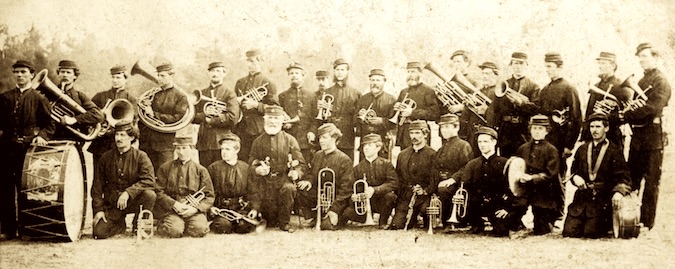
The 22nd Battalion Oxford Rifles Band (volunteer militia), circa 1870. Left to Right, back row; W Murray, "Oklahoma Bill", Unknown, Homer Brown, Joseph Anderson, J Hay Brown, Bandmaster Merchant (SIC), J McDonald, W H Spinks, Capitan Wilson, Wm Scarff, D Clyde, W R Murray, W Toop, D Fisher, Robert Barr, Charles Wilson. (Photo courtesy of Woodstock Museum National Historic Site.) |
|
| Personal Information |
Census Image |
|
| Name: |
|
William Marchant |
| Age: |
|
42 |
| Home in 1871: |
|
Woodstock, Oxford-North, Ontario |
| Religion: |
|
Church of England |
|
|
|
|
SOURCE INFORMATION: Library and Archives Canada. Census of Canada, 1871. Ottawa, Ontario, Canada: Library and Archives Canada, n.d. RG31-C-1. Year: 1871; Census Place: Woodstock, Oxford North, Ontario; Roll: C-9912; Page: 32; Family No: 126.
|
|
The 22nd Battalion Volunteer Militia Rifles Canada, as it was otherwise known, was formed and headquartered at Woodstock, Ontario, on 14 Aug 1863. In 1864, Major John B. Taylor was promoted to the command of the Battalion, and the regiment was active participating in the Fenian Raids in Quebec.
Canada was going through changes as well: On July 1, 1867, a new, self-governing mega-colony known simply as the Dominion of Canada was formed. The old United Province of Canada was split into two pieces, Ontario for the English and Quebec for the French, which, along with New Brunswick and Nova Scotia, became the confederation's first four provinces. There were still other conflicts for the military, however. In 1868, the militia was called out in the County of Oxford to aid with civil power in the event know as "The Whisky Riots," when the Mayor of Woodstock, William Grey, requested assistance in dispersing a crowd which had collected and threatened two "whiskey detectives."
By the 1871 census, William's listed as a 42 year-old musician, in District 14, Sub District E, Division Page 1, Page 32, Woodstock Township, Oxford County, in southwestern Ontario. In Lovell's Canadian Dominion Directory for 1871, William is listed in Woodstock, under the mysterious heading of "groceries," but as a music master (professor of music) in the 1881 Census:
| Name |
Marital Status |
Gender |
Ethnic Origin |
Age |
Birthplace |
Occupation |
Religion |
| WILLIAM MARCHANT |
M |
Male |
English |
52 |
England |
Music Master |
Church of England |
| MARTHA MARCHANT |
M |
Female |
English |
48 |
Ontario |
-- |
Church of England |
| ROBERT MARCHANT |
-- |
Male |
English |
24 |
Ontario |
Printer |
Church of England |
| SOPHIA MARCHANT |
-- |
Female |
English |
19 |
Ontario |
Dress Maker |
Church of England |
| MARY MARCHANT |
-- |
Female |
English |
14 |
Ontario |
-- |
Church of England |
| HARRIET MARCHANT |
-- |
Female |
English |
11 |
Ontario |
-- |
Church of England |
1881 ONTARIO CENSUS: Woodstock, Oxford North, Ontario; Family History Library Film 1375903; NA Film Number C-13267; District 166; Sub-district E; Division 2; Page Number 48; Household Number 254
|
|
| Personal Information |
Image |
|
| Name: |
|
William Marchant |
| Locality: |
|
Ingersoll |
| Province: |
|
Ontario |
| Country: |
|
Canada |
| Year: |
|
1884 |
|
|
|
|
SOURCE INFORMATION: Ontario, Canada Voter Lists, 1867-1900: Various Voter Registration Lists from Ontario, 1867-1900, collected by Canadiana.org.
|
Eventually they moved to 4 South Gravel Road in Ingersoll, the township next to Woodstock, in Oxford County in Southwestern Ontario, on the Thames River (it was originally called "Oxford-on-the-Thames" then established as a town in 1861). In 1866, a giant block of cheese weighing 7,300 pounds (3,311 kg) was produced at the James Harris Cheese Factory for promotion of the town's cheese industry. The "Big Cheese" was exhibited in England and in the United States at the New York State Fair in Saratoga. Aimee Semple McPherson, future American evangelist, was born there in 1890. William was still there in 1884, when he showed up on the voter registration list.
But William and Martha's family began to disperse. Daughters Harriet, Sophia and Jane Marchant married and moved away to start their own families, and then William Marchant Jr., left Canada for the United States with his family in 1884. Martha died from consumption in 1886, and their son, Robert, passed away in August of that same year. Then daughter May Marchant Morrey died in 1887. William Marchant Sr. buried them all in the Ingersoll Public Cemetery... and suddenly, he was alone for the first time in his life. He was also struggling with acute bronchitis, which robbed him of his ability to play music. He was alone on the harsh Canandian frontier, in poor health and unable to work. Just about everything he loved was gone, or far away. So he made a decision to go home to the country of his birth.
| Personal Information |
Marriage Record |
| Name: |
|
Robert
Marchant |
| Spouse: |
|
Margaret Carricque |
| Marriage Date: |
|
4 Nov 1861 |
| Parish: |
|
St Mary, Lambeth |
| Residence: |
|
Westminster Rd. |
| Father Name: |
|
John Marchant |
| Occupation: |
|
Lath Render |
| Condition: |
|
Widower |
|
|
|
| Personal Information |
Marriage Record |
| Name: |
|
Robert Marchant |
| Spouse: |
|
Ann Robert(s) |
| Marriage Date: |
|
19 Feb 1868 |
| Parish: |
|
Holy Trinity, Lambeth |
| Bourough: |
|
Lambeth |
| Father Name: |
|
John Marchant |
| Spouse Father: |
|
John Humphreys |
| Occupation: |
|
Lath Render |
| Condition: |
|
Widower |
|
|
|
|
|
SOURCE INFORMATION: Church of England Parish Registers, 1754-1921. London Metropolitan Archives, London. Left: London Metropolitan Archives, Saint Mary At Lambeth, Register of marriages, P85/MRY1, Item 433; Banns: London Metropolitan Archives, Saint Mary At Lambeth, Register of banns of marriage, P85/MRY1, Item 540. Right: London Metropolitan Archives, Holy Trinity, Lambeth, Register of marriages, P85/TRI1, Item 014.
|
| Article Information |
Newspaper |
| Newspaper: |
|
Maidstone Telegraph |
| Date: |
|
Saturday 18 June 1870 |
| Page: |
|
5 |
| Column: |
|
3 |
| Title: |
|
Suicide |
| Subject: |
|
George Marchant |
| Date of incident: |
|
13 Jun 1870 |
|
|
|
|
|
SOURCE INFORMATION: The British Library, 96 Euston Rd, London NW1 2DB; Maidstone Telegraph No. 607, founded in Kent in 1859 by Mr J. Lurcock, who ran a library in Earl Street, Maidstone.
|
Back in England, things hadn't been going well for the previous generations of the family, either. William's grandmother Sarah Marchant was buried on 06 Sep 1846 in Maidstone (FHL Film #1835479; Reference ID: R194 item 2 P58 R463), and grandfather John Marchant had passed away on 01 Aug 1852 (Holy Trinity, Maidstone, Kent, England; FHL Film #1835480; Reference ID: item 1). William's uncle George Marchant committed suicide by hanging himself in 1870 (see the article, at right).
William's father, Robert Sr., had been experiencing loss, himself. On 6 Dec 1859, his second wife, Ann Marchant had died after 14 days of paralysis in the sub-district of Trinity-Newington (Newington, Surrey General Register Office, #4254920/1). Robert went on to marry the widow Margaret Hearn Carricque on 4 Nov 1861, and after her, another widow named Ann Humphries Roberts on 19 Feb 1868 at Holy Trinity, Lambeth, England. His last (fourth?) wife died sometime before 1871. After that, all the years of being an absentee father finally caught up with Robert. Despite having children and other relatives living near to him in the London area, nobody took him in when he needed help. He spent most of his final years alone in workhouses, poor in wealth and poor in health.
In 1871, "destitute widower" Robert spent two days in St George-the-Martyr Parish workhouse, in Southwark. That institution was the subject of one of a series of articles in the medical journal The Lancet in September of 1865, investigating conditions in London workhouses and their infirmaries. The report revealed a catalogue of appalling conditions in the building: "For the last three years and a half this house appears to have suffered from various epidemics, and especially from typhus. Many cases are admitted into the house from the neighbourhood; but many are developed in the house." Robert may have been a victim, himself, because two days after being admitted he was transferred to the Newington hospital in Surrey, London.
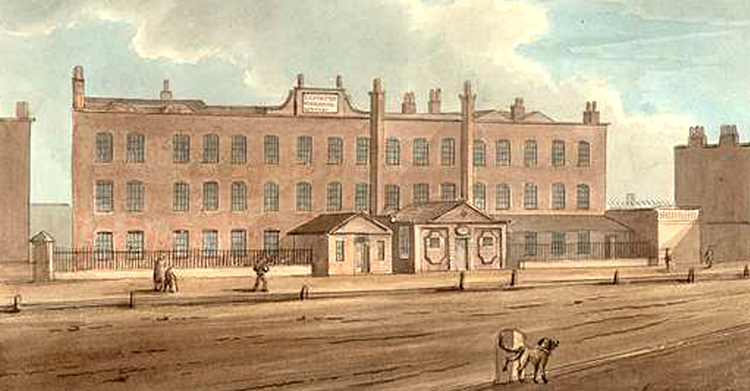
The Lambeth Poor Law Parish, aka the Lambeth Princes Road Workhouse, circa 1850 (now on Black Prince Rd, Lambeth, London SE11 6HX, UK). |
"The most acute cases of sickness are lodged in two wards (one male and one female), which are called the 'sick wards,' and contain about seventy patients. These wards, though far too crowded, are most creditably managed; they are generally filled with cases so severe in character that they might well occupy the entire attention of one medical man... But the enormous number of cases requiring frequent medical attention in the house make it impossible that the surgeon should do full justice to his duties."
—"The Lancet," report on the Lambeth workhouse, published on 4th November, 1865.
|
| Newspaper Information |
Newspaper Image |
|
| Newspaper: |
|
The Poor Man's Guardian |
| Subject: |
|
Lambeth Workhouse |
| Date: |
|
13 Nov 1847 |
| City: |
|
London |
| Hundred: |
|
Maidstone |
| County: |
|
Kent |
|
|
|
|
SOURCE INFORMATION: British Library Board; Shelfmark: P.P.1103.
|
|
The Lambeth Union Workhouse, where Robert would spend the bulk of his remaining years, was the center of an 1866 under-cover exposé of its casual ward by journalist James Greenwood in the Pall Mall Gazette. Greenwood's report ('A Night in a Workhouse') contained graphic descriptions of the primitive accommodation: "No language with which I am acquainted is capable of conveying an adequate conception of the spectacle I then encountered. Imagine a space of about 30ft. by 30ft. enclosed on three sides by a dingy whitewashed wall, and roofed with naked tiles which were furred with the damp and filth that reeked within... At one glance my appalled vision took in 30 of them—thirty men and boys stretched upon shallow pallets with but only six inches of comfortable hay between them and the stony floor." It also described a "mutton broth bath" in which inmates were expected to bathe.
That same year, Lambeth was also featured in The Lancet and the report noted that the almost five-sixths of the inmates required medical care. Around seventy inmates were in the workhouse 'insane wards'. The only paid nursing staff were the the male superintendent of the infirmary (who also acted as dispenser), a female superintendent sick-nurse who also acted as midwife, and male and female superintendents of the "lunatics." They were assisted by seventy-two 'pauper nurses,' who received additional food for their work. No paid staff were on duty at night.
Documents at the London Metropolitan Archives show that Robert kept entering and leaving the workhouse on his "OR" ("Own Request"), so he may just have used the workhouse as a stopover between jobs. But as he grew older, the stays grew longer and more frequent:
WORKHOUSE ADMISSION AND DISCHARGE RECORDS |
| Date In |
Name |
Age |
Church |
Workhouse |
Occupation |
Date Out |
| 02 May 1871 |
Robert Marchant |
70 |
CofE |
Southwark |
Lath Render |
04 May 1871 |
| 24 Sep 1872 |
Robert Marchant |
70 |
CofE |
Lambeth |
N/A |
04 Dec 1872 |
| 07 Jan 1873 |
Robert Marchant |
70 |
CofE |
Lambeth |
Lath Render |
05 May 1873 |
| 17 Nov 1873 |
Robert Marchant |
61 |
CofE |
Lambeth |
Labourer | 2 Apr 1874 |
| 09 Jul 1875 |
Robert Marchant |
72 |
CofE |
Southwark |
Lath Renderer |
22 Nov 1875 |
| 28 Feb 1876 |
Robert Marchant | 60 |
CofE |
Lambeth |
Lath Render |
13 Jun 1877 |
| N/A |
Robert Marchant |
74 |
CofE |
Southwark |
Lath Render |
26 Aug 1878 |
SOURCE: London, England, Workhouse Admission and Discharge Records: Board of Guardians records held by the London Metropolitan Archives, London, England.
|
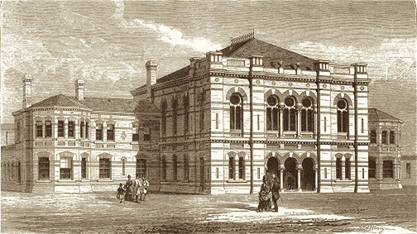
Lambeth Renfrew Road Workhouse, circa 1873. |
In 1873, a new Lambeth Workhouse in Renfrew Road replaced the old workhouse in Prince's Street, and was designed for 820 inmates. A contemporary report in The Builder stated: "A system of rigid classification has been carried out....the several classes in each sex are for aged, able-bodied of good character, and two subdivisions of able-bodied of bad character." Robert needed to avoid the latter group, who were fed only weak broth and bread. He was probably in poor health, as age had caught up to him. At Lambeth, he was always signed in by the same person, "Ames," with whom he may have had an arrangement to knock some years off his registered age, in order to avoid being sent to the Infirmary with the people too old and/or feeble.
Robert Sr.'s brother William may have joined him in the workhouse about this time. According to their descendants, they had been very close, and lived near each other in Deptford (SE London). A "William Marchant, CofE," whose age was given as 71, entered the workhouse on 21 Jul 1873, and was a lath render from 34 Irston Street. (He had either lived hard, or his age was inflated, as he would actually have only been about 60.) A Sarah Marchant (William's wife) died in Greenwich (included Deptford) in 1872, so he may have come to Lambeth to be near his brother. William left the workhouse on 4 Nov 1873, but records show that a William Marchant died in Southwark, Surrey, London, soon after in 1874.
Robert was back in Southwark workhouse in August of 1878, and then he entered Lambeth sometime around 1880/81. The Lambeth workhouse records from that time are missing, so we don't know exactly when Robert re-entered the workhouse, but he was there for the 1881 census, in the dreaded Infirmary wing.
| Personal Information |
Census Image |
| Name: |
|
Robert
Marchant |
| Age: |
|
77 |
| Est. Birth Year: |
|
1805 |
| Relationship: |
|
Patient |
| Born: |
|
Maidstone,
Kent,
England |
| Civil Parish: |
|
Lambeth, London, England |
| Address: |
|
Workhouse Infirmary |
| Occupation: |
|
Lath Render |
|
|
|
| Personal Information |
Census Image |
| Name: |
|
William
Marchant |
| Age: |
|
62 |
| Est. Birth Year: |
|
1829 |
| Relation: |
|
Brother |
| Where Born: |
|
Maidstone, Kent, England |
| Civil Parish: |
|
Liverpool |
| Ecclesiastical Parish: |
|
St Matthias |
| County: |
|
Lancashire, England |
| Occupation: |
|
Port Watchman |
|
|
|
|
|
SOURCE INFORMATION: Census Returns of England and Wales: 1881. Kew, Surrey, England: The National Archives of the UK (TNA): Public Record Office (PRO), 1881. Class: RG11; Piece: 599; Folio: 117; Page: 8; GSU roll: 1341137. 1891: Kew, Surrey, England: The National Archives of the UK (TNA): Public Record Office (PRO), 1891. Class: RG12; Piece: 2904; Folio: 43; Page: 8; GSU Roll: 6098014
|
| Death Record |
Image |
| Name: |
|
Robert Marchant |
| Birth Year: |
|
@ 1805 |
| Registration Year: |
|
1884 |
| Registration Quarter: |
|
Jan-Feb-Mar |
| Age at Death: |
|
73 |
| Registration District: |
|
Lambeth |
| County: |
|
London |
| Volume/Page: |
|
1D, 283 |
|
|
|
SOURCE INFORMATION: General Register Office. England and Wales Civil Registration Indexes. London, England: General Register Office.
|
Robert Marchant Sr., died alone at the Lambeth workhouse in 1884, and there is no record of any family funeral or memorial. So even if he had wanted to see his son William again, he died before he could witness his son's return to England. William wasn't in great health, himself. Bronchitis had robbed him of his ability to play his instrument, so he had to find a new occupation to compliment a small army pension.
Although fifty years had passed since brothers William and Robert Marchant Jr., had escaped the workhouse—and despite living across the world from each other for most of that time—their bond was still strong. After the death of a wife, son, and daughter, William Marchant Sr., sailed back to England and moved in with his brother on Regent Street in Liverpool. William stayed in the Liverpool workhouse from January to March in 1890, listed as a musician, and he seems to be recovering from a skin condition/infection. (Psoriasis does run in the Marchant line.) In the 1891 census of England, William is living with Robert's family and working for his brother as a port watchman. William must have delighted his nieces and nephews with his tales of military adventure on a far-off continent, and of North American cousins whom they had never met.⁴ But Robert Jr.'s wife Elizabeth Lambert-Marchant passed away in 1891, and at some point after that Robert and daughter Elizabeth (1882-1896) went to live with his other daughter, Mary Marchant-Sarsfield (1869-1954), and her family in Eldon Place, leaving William on his own. It doesn't seem as though either brother ever had a desire to revisit Maidstone, with both parents deceased and no siblings remaining.
| Death Certificate |
Image |
| Name: |
|
William Marchant |
| Place: |
|
County of Liverpool |
| Date: |
|
16 Dec 1896 |
| Profession: |
|
Army Pension |
|
|
|
SOURCE INFORMATION: Collection of Paul Harrington.
|
William Marchant Sr., died on 16 Dec 1896 in Liverpool, from acute bronchitis. His death certificate (at right) lists him as a widower and an army pensioner, living on Carlton Street, just next to where he'd been living with Robert. It's the address listed on his death certificate, and it looks as if the landlady (who could only make her mark) was present at his death. The one bright spot in this is that although there was no family with him at the time of death, he didn't die a workhouse like his father—although after the Diseases Prevention Act of 1883, workhouse infirmaries did offer treatment to non-paupers as well as inmates. William is buried at the Anfield Cemetery in the Metropolitan Borough of Liverpool, Merseyside, England. He's in Church of England section 13, grave number 587 (as it's a public grave, there is no headstone).
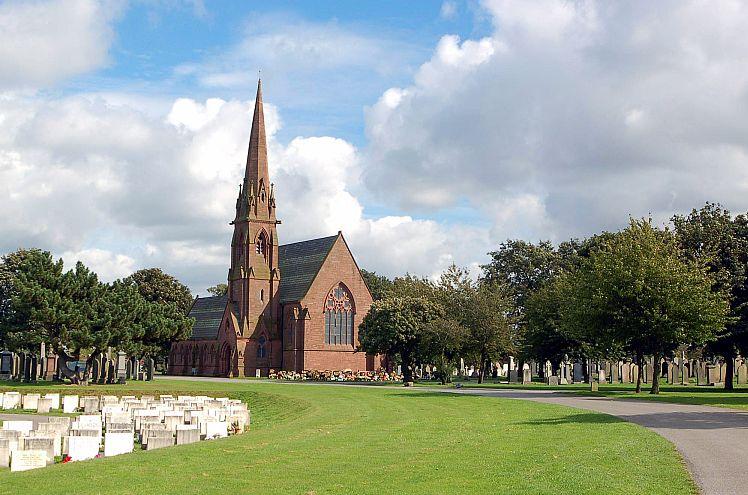
Anfield Cemetery, or the City of Liverpool Cemetery, located in Anfield, a district of Liverpool, Merseyside, England. |
Back in North America, the next ancestor in our line, WILLIAM HENRY MARCHANT (b. 26 Dec 1850), became a musician like his father—and probably a soldier, as a Private William Marchant was listed in the 26th Regiment, Middlesex Light Infantry in 1880. He married MARTHA HOLLAND (14 May 1852 - 16 Jan 1911), in Bothwell, Ontario, on 26 Oct 1870. They were also members of the Church of England, like William's parents. In the 1871 Ontario census, they are living in Niagara with William's uncle, Samuel Read and his family (Niagara, Niagara, Ontario; Roll: C-9921; Page: 9; Family No: 35). Interestingly, he may have been there for military duty, as Niagara-on-the-Lake was an area under siege when Irish Americans attacked Canada in protest over British rule of their motherland. Being Irish, Martha may have been a little torn. Her parents were CHARLES HOLLAND, according to Ingersoll directories of the time, and MARJERY (or MARJORY) BROWN, who came with her sisters from Ireland (County Caven). Marjory lived to be 94 years old, according to the Marchant Bible, so hopefully, with this long-lived Irish blood now pumping in the Marchant veins, the next generation would do better.
Then they settled in the township of London, Middlesex to raise a family. The present site of London was occupied for 10,000 years by several Odawa and Ojibwe villages, which were driven out by the Iroquois by 1654 in the Beaver Wars. London was founded by European settlers in 1826. The main activities in the town appeared to have been floods and fires. In 1845, a fire destroyed much of London, with one of the first casualties being the town's only fire engine. The town's only connection with other communities was by road using mainly stages that ran daily, until the arrival of the railway in 1853. By 1870, London had a population of about 18,000 served by three newspapers, churches of all major denominations and offices of all the major banks. Industry included several tanneries, oil refineries and foundries, four flour mills, the Labatt Brewing Company and the Carling brewery. In 1875, London's first iron bridge, the Blackfriars Street Bridge, was constructed, replacing a succession of flood-failed wooden structures that had provided the city's only northern road crossing of the river. The William Marchant Jr. family arrived in London sometime before the 1881 census, with relatives in nearby Woodstock, Bothwell and Ingersoll.
Unfortunately, their first child, Fredie Thomas Marchant, lived less than a year. But their next child, a daughter named Lillie, was healthy and strong. This is how the family was listed in the 1881 Ontario census:
| Name |
Marital Status |
Gender |
Ethnic Origin |
Age |
Birthplace |
Occupation |
Religion |
| WM. MARCHANT |
M |
Male |
English |
30 |
Ontario |
Musician |
Church of England |
| MARTHA MARCHANT |
M |
Female |
English |
28 |
Ontario |
-- |
Church of England |
| LILLIE MARCHANT |
-- |
Female |
English |
3 |
Ontario |
-- |
Church of England |
1881 ONTARIO CENSUS: Ward 3, London, Middlesex, Ontario; Family History Library Film 1375906; NA Film Number C-13270; District 170; Sub-district C; Division 2; Page Number 1; Household #5
|
|
| Personal Information |
Image |
|
| Name: |
|
William H. Marchant |
| Locality: |
|
London West |
| Province: |
|
Ontario |
| Country: |
|
Canada |
| Year: |
|
1883 |
|
|
|
|
SOURCE INFORMATION: Ontario, Canada Voter Lists, 1867-1900: Various Voter Registration Lists from Ontario, 1867-1900, collected by Canadiana.org.
|
William appeared on the voters lists in 1877, 1878, 1880, 1881 and 1883 in Londown Township, but around 1884, the Marchant family crossed from Southern Ontario into Port Huron, Michigan, down to Kalamazoo, 290 miles away in the the southwest region of the state. Michigan was a favorite 19th-century destination of Canadians leaving Ontario (about one out of every four Michigan families finds a direct connection to Ontario). But why they ended up in Kalamazoo of all places is lost to time—although William had started a busines there as a music teacher and is listed on page 141 of the 1880 Kalamazoo City Directory at 217 West Vine Street (still standing, but now a residence). There were some Marchants already living in Kalamazoo, as well. A man named John Marchant was an inventor and had secured several U. S. patents; one being for the "Trim-O-Saw"—a machine used in paper mills and printing offices. He was part owner of the American Tool & Die Co. at Kalamazoo, and married Frances Helen Wilson Marchant. They had the following children: Margaret Marchant (b. 29 Dec 1858) and Frances Helen. Were these Marchants related? Was John a cousin of William Sr.? Heck if I know.
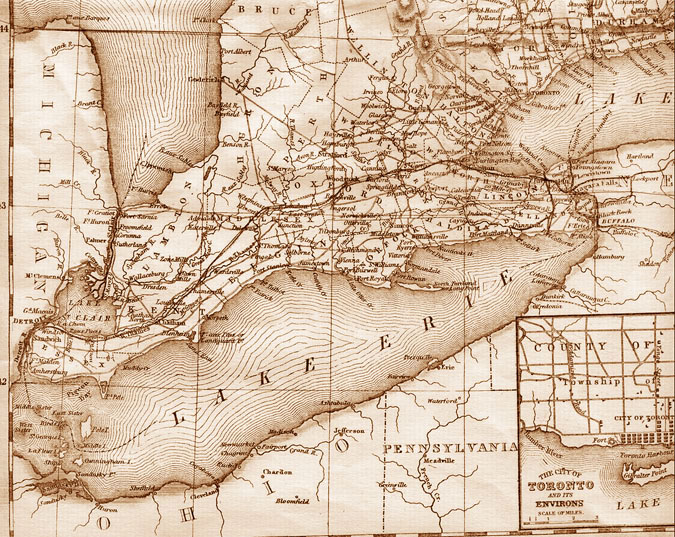
The border of Canada and Michigan in 1850, with St. Clair County, MI, at left (click to enlarge).
|
Another clue to the move to Kalamazoo is in the possession of Lillie Marchant's daughter-in-law, Gloria Benson: a sampler, which Lillie said had been made by her "Aunt Mary." MARY ANN PARKER, born in 1809 in Cavendish, Vermont, made the sampler in 1822. We don't know if she was blood kin or married into the Marchant line, but with the timeline involved, she would probably be a great-aunt. Mary Ann Parker married Hosea B. Huston, and became pioneers in Kalamazoo County. Her older sister, Eliza, married Thaddeus Smith, and they settled in Kalamazoo County in 1830. Their brother, John Parker, also ended up there. So how are they related to us? Again, I have no idea.⁸ It could just be that William was getting more work in Michigan and decided to move his family to the neighboring country, where there was more opportunity.
Once they had settled in Kalamazoo, William and Martha had another daughter, MARJORIE EVELYN MARCHANT, born on 5 Apr 1892. She may have been a surprise, as she was 14 years younger than her sister Lillie, and her father William was 41 and Martha was 39. But it was undoubtedly a happy, if unexpected, occasion. The children of William and Martha were:
CHILDREN OF WILLIAM MARCHANT AND MARTHA HOLLAND |
| FREDIE THOMAS MARCHANT was born on 10 May 1872, according to the Marchant family bible. He died on 10 Feb 1873, at the age of 10 months. |
|
LILLIAN "LILLIE" MAUD MARCHANT was born on 11 Jan 1878 in Ontario, Canada. She became a music and art teacher in Minnesota and married HENRY NATHANIEL BENSON (1 Aug 1872 - 10 May 1960), who served as a state senator and Attorney General in Minnesota. They had three children: Alice Merle (1908-1986), Margaret Lucille (1909-1993), and Henry (1917-1993), and lived in St. Peter, Nicollet, Minnesota. Lillian died in 1942 and is buried at Woodlawn Cemetery in Saint Peter, Le Sueur County, Minnesota.
|
|
MARJORIE EVELYN MARCHANT was born on 5 Apr 1892 in Kalamazoo, Michigan. She grew up in Macomb County, Michigan, near a boy named CARLISLE HAUSE. When her mother died, she moved to Minnesota with her sister. Carlisle then traveled to Minnesota, proposed, and brought her back to Michigan. Her death from breast cancer in 1939 was so unendurable for Carlisle that he set fire to all of his photographs of her, trying to burn her from his memory. The only images that we have of her today are from in-laws. Burial: Woodmere Cemetery, 9400 W Fort Street, Detroit, Wayne County, Michigan; Telephone: (313) 841-0188
|
| Book Information |
Book Image |
| Name: |
|
Marchant Family Bible |
| Author: |
|
Martha Holland Marchant |
| Year: |
|
1880-- |
| Pages: |
|
13 |
|
|
|
SOURCE INFORMATION: Benson family.
|
William Henry Marchant flourished in Kalamazoo, giving music lessons for both voice and instrument, as well as leading the Comstock, Richland and the Oshtemo bands. He was also the leader of the First M. E. Church choir, and the Kalamazoo Daily Telegraph noted on 24 Jan 1888 that "his deep bass voice held the attention of all present." William even led the YMCA Orchestra, and helped put together a successful six-piece dance orchestra with musician, photographer and merchant Wallace S. White. William and White then created a brass band with members of the YMCA Orchestra and perhaps players from a local Odd Fellows (African American) orchestra.
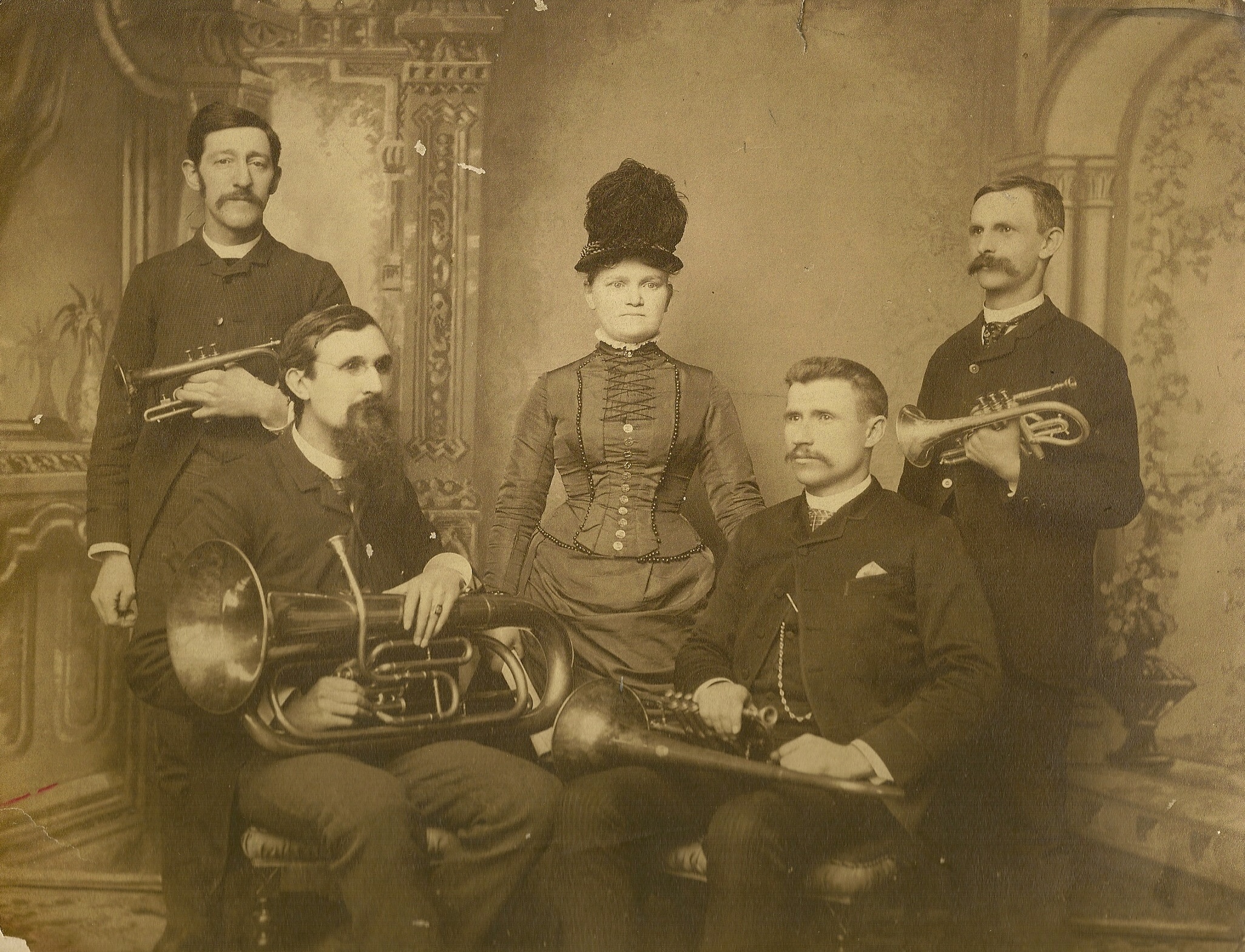
Professor William Henry Marchant, holding bugle, with band. (Image from the Marchant family Bible, courtesy of Gloria Benson) |
| Publishing Information |
Sheet Music |
| Title: |
|
I Heard the Voice of Jesus |
| Words by: |
|
Rev. H. Bonar |
| Music by: |
|
W.H. Marchant |
| Publisher: |
|
W.S. White |
| Location: |
|
Kalamazoo |
| Instrumentation: |
|
Piano and Voice |
|
|
|
SOURCE INFORMATION: The Lester S. Levy Sheet Music Collection: Johns Hopkins Sheridan Libraries an University Museums, Box 141, item 046.
|
William also helped organize the Kalamazoo Harmonic Band (Harmonic Brass Band) on 13 Apr 1894. Most of its seventeen members had been associated with other local bands and were well known musicians. They were managed by Frank E. Wilson, a local letter carrier and versitile musician, and directed by William. The outfit (occasionally called the "Harmonica Band," although they were definitely not playing harmonicas) made its debut on 1 Aug 1894, during the annual Emancipation Day parade and celebration in Kalamazoo; later taking center stage for an evening concert at Turn Verein Hall. By November, the band was able to secure new uniforms and showed them off proudly during a year-end concert at the G.A.R. Hall. That same year, William was enlisted as Kalamazoo's Philharmonic Orchestra musical director and librarian, and was listed as playing the corno (horn) in January 1895. He also composed music hymns and marches. ("The new march which White's Band played in the parade Wednesday was composed by Prof. W.H. Marchant"—Kalamazoo Gazette, 23 Aug 1895.) He may have also worked in Detroit, as he placed advertisements for his services in the Detroit Free Press, and his music was played there by bands and church choirs for years after his death.

Ad in the Detroit Free Press on on 16 Oct 1891. |

The First M.E. (Methodist) Church. It burned down in 1926. |
In January of 1896, William developed pneumonia. He seemed to recover after about three weeks, but the Kalamazoo Daily Telegraph reported on Monday, 17 Feb 1896 that "W.H. Marchant was taken worse yesterday afternoon and it is thought that he can survive but a short time." The paper also noted that the temperature outside was several degrees below zero, which did not bode well for someone in William's condition. Despite the weather, the newspaper then announced there would be a "Marchant Benefit Concert" on Wednesday, 19 Feb 1896 at the First M.E. (Methodist) church with tickets costing twenty-five cents, calling the event "One of the finest programs ever rendered in Kalamazoo." The benefit featured the Ideal Mandolin Orchestra and Morse Glee Club. It was also one of the Philharmonic Orchestra's final performances. In addition to its established membership, the ensemble featured several additional local musicians who were close friends of William. Rehearsals for the benefit performance were heard in New York, Chicago, Detroit, Buffalo, Cincinnati, Cleveland, and elsewhere, thanks to a newly installed long distance telephone connection. For its portion of the program, the Philharmonic Orchestra performed an overture by François-Adrien Boieldieu, a suite of Strauss waltzes, and closed with a Sousa march (symphony director Chester Z. Bronson had just finished a tour with Sousa's band). On 21 Feb, the Daily Telegraph announced the benefit had garnered $100, and that, "Friends will be pleased to learn that W.H. Marchant is gaining in strength." But the recovery, like William, was short-lived.
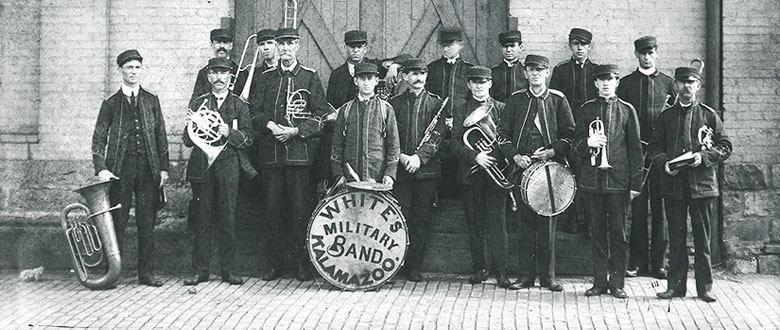
White's Military Band of Kalamazoo, early 1890s; Chester Bronson is holding a clarinet, William H Marchant is in the right corner, holding the books (Wallace White collection, Kalamazoo Public Library, KPL catalogue number P-478). |
"W. H. Marchant passed away this morning at 9:45 of nervous prostration. He was taken sick about eight weeks ago with pneumonia, from which he suffered about three weeks. He was born in Niagara, Canada, and was about 44 years of age. Mr. Marchant lived for some years in London, Canada, and removed to Kalamazoo in 1885. He was one of the best known musicians in the city, giving lessons both in voice culture and on wind instruments."
—Kalamazoo Daily Telegraph, 9 Mar 1896.
| Newspaper Information |
Article Image |
| Newspaper: |
|
Kalamazoo Daily Telegraph |
| Obituary: |
|
William Henry Marchant |
| Date: |
|
9 Mar 1896 |
| Page: |
|
2, par. 3 |
| Funeral notice: |
|
11 Mar 1896 |
| Ingersoll Burial Notice: |
|
14 Mar 1896 |
|
|
|
SOURCE INFORMATION: Thanks to Alexander P. Merrill, Library Assistant, Kalamazoo Public Library. Phone: 269-553-7873 (www.kpl.gov).
|
After weeks of battling, William Henry Marchant passed away at 9:45 am on 9 Mar 1896, from extreme mental and physical fatigue. A funeral was held at the First M. E. Church in Kalamazoo on the 11th, then William's remains were transported to Ingersoll, Ontario, on the 14th by Martha, accompanied by William's's sister, Sophia Badden, and an in-law of Martha's sister Rebecca named Burt Glover. He is buried at Ingersoll Rural Cemetery in Ingersoll, Oxford County Municipality, Ontario, Canada, along with his mother, brother Robert, and his sister May Marchant Morrey.
Martha, suddenly alone, was left to care for the family herself. Meanwhile Marjorie, almost four, had lost a father she hardly knew. If William Sr. was informed in Liverpool of his son's death in America, we have no record of it—but he ended up outliving his last surviving son by six months.
Martha is listed as a single widow living at 77 Columbia East in the 1897 Detroit City Directory while Lillian works as a music teacher at the same residence. But Lillian's life would soon change with a job opprtunity in a different state:
"In 1899 Miss Marchant was called to Saint Peter to take the position of supervisor of music and drawing in the public schools of that city and she was thus engaged, performing a most admirable service in behalf of the youth of St. Peter, until her marriage to Mr. Benson, since which time she has been a most competent and valuable helpmate to him. Both Senator and Mrs. Benson take an active and warm interest in various social and cultural activities of St. Peter and are held in the highest esteem throughout the whole community."
—"History of Nicollet and LeSueur Counties, Minnesota; Their People, Industries and Institutions, Volume II" by Hon. William G. Gresham, Editor-in-Chief.
Martha and Marjorie moved to Richmond Township, in St. Clair County, Michigan, where Martha found work as a housekeeper. Lillie went into her father's business and taught music and art in Minnesota, at the St. Peter public school in 1899. Lillian was very smart, musical and artistic, like her father, and it took several years for her to meet her creative match and settle down. On 27 Sep 1904, Lillian married a lawyer from Minnesota named Henry Nathaniel Benson (b.1 Aug 1872). They honeymooned in San Francisco (two years before the earthquake), then started a family in Minnesota.
A Republican, Henry eventually was elected a member of Minnesota state senate, serving from 1910-23; he was then a probate judge in Minnesota, 1928; and after that was appointed the Minnesota state attorney general, from 1929-33. According to daughter-in-law Gloria Benson, Lillian was an activist in women's clubs—literary and music—and national peace organizations, and her Irish wit and sense of humor are still talked about all these years later.
Meanwhile, Martha Holland-Marchant remained in Michigan. In the 1900 census of Richmond Township in Macomb County, she's listed as a widow and a servant to a day laborer named Manly C. Gilbert, a widower himself, with a ten-year-old daughter, Mabel, and a two-year-old son named Russell. But in another twist, on 06 Nov 1902, Martha married Gilbert, in Memphis, (in the wedding document, named Charles S. Gilbert, born 1842 in Memphis, Macomb county, Michigan. Film number: 2342522; Digital GS number: 4032371; Image number: 387; Reference number: v 3 p 177 rn 3737). It's unknown how Marjorie and her stepfather got along, but the Port Huron Times Herald of 31 Aug 1907 reported that Marjories was leaving for Minnesota to live with her sister for a year. Curiously, Martha and Marjorie are together again in the 1910 census, but living alone:
|
| Personal Information |
Census Image |
|
| Name: |
|
Martha Marchant |
| Home in 1900: |
|
Richmond, Macomb, Michigan |
| Age: |
|
48 |
| Birthplace: |
|
Canada |
| Relationship to head-of-house: |
|
Servant |
| Marital Status: |
|
Widow |
|
|
|
|
| Personal Information |
Census Image |
|
| Name: |
|
Martha Gilbert |
| Home in 1910: |
|
Richmond, Macomb, Michigan |
| Age: |
|
58 |
| Birthplace: |
|
Canada |
| Relationship to head-of-house: |
|
Head |
| Marital Status: |
|
Wife |
|
|
|
SOURCE INFORMATION: Data imaged from National Archives and Records Administration.
|

| Martha Holland Marchant posing with grandchildren Alice and Margaret Benson (photo courtesy of Gloria Benson). |
|
It was about this time that Marjorie was in high school, and was being courted by an athletic, dry-humored, blonde young man named CARLISLE HAUSE. But in Marjorie's junior year, she moved with her mother to Detroit. This might have ended the romance, but Martha Holland-Marchant passed away there on 16 Jan 1911. The Port Huron Times Herald newspaper, reported in its Memphis section on January 21, 1911: reported: "Word reached here Tuesday that Mrs. Chas. Gilbert who formerly resided here, but has made her home in Detroit since last summer was dead from an injury received in getting off from a street car." Interestingly, her death certificate lists her as a widow, even though Gilbert would live until 1917 (he's buried in the Memphis Cemetery, while Martha is interred at Woodmere Cemetery in Detroit, under the name "Martha Marchant Gilbert").
Marjorie was forced to move in with her sister's family in Minnesota. But back in Michigan, Carlisle Hause couldn't stand to live without her anymore. He traveled to Minnesota and swept Marjorie off her feet. She returned with him to Macomb County. Here's her bio in the Memphis High yearbook for that year:
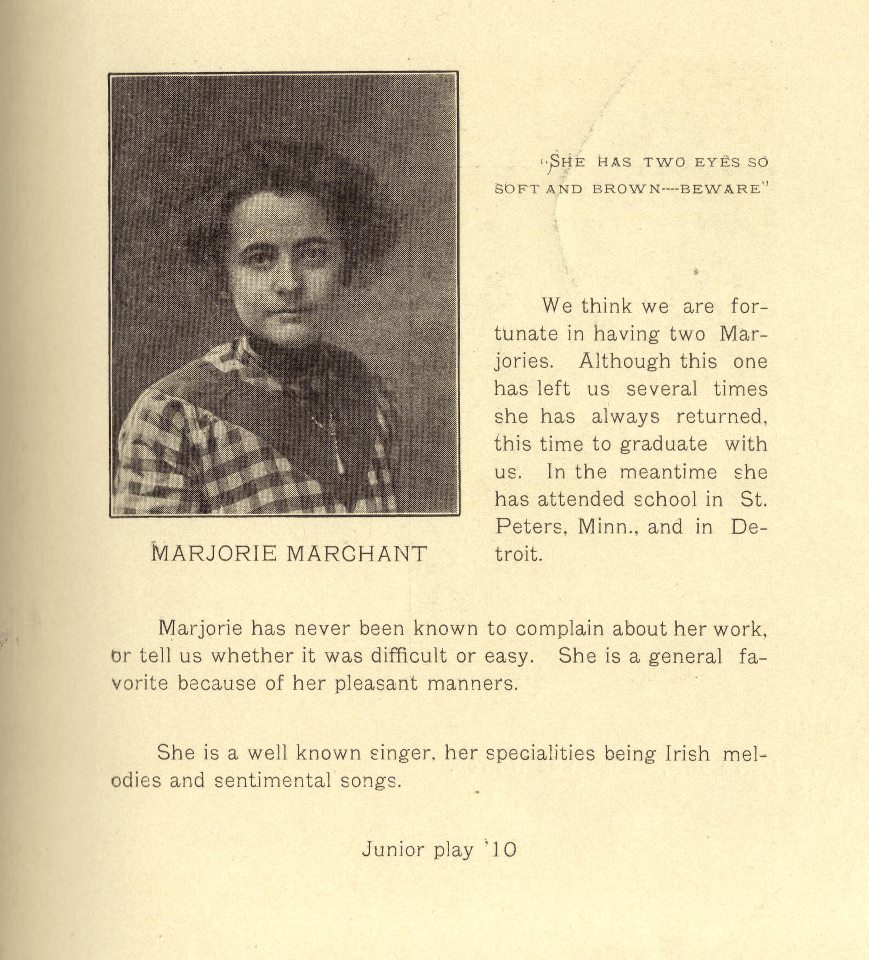
Marjorie Marchant in the 1911 Memphis School Yearbook. (Thanks to Ruth Koppinger Suwalkowski of Memphis for the scan.) |
| Newspaper Article |
File Image |
| Title: |
|
Carlisle and Marjorie Marchant Hause |
| Subject: |
|
Wedding |
| Original Publication Date: |
|
1911 |
|
|
|
Marjorie married Carlisle that summer, on 16 Aug 1911 at the home of her sister and brother-in-law in Minnesota. At first they boarded in his parents' rooming house in Ypsilanti while he finished school (see them on page 539 of the Polk's 1914 County Directory).
After Carlisle's graduation, they moved to Detroit, where he taught, while she graduated from the Michigan State Normal College. (It's now known as Michigan State University, it was then a school created to train high school graduates to be teachers. Its purpose was to establish teaching standards or norms, hence its name.)
Marjorie and Carlisle would prosper, even through the Great Depression, when his tenured salary allowed them to buy a lakehouse upstate in Glennie, Michigan, on Vaughn Lake. They had two children:
CHILDREN OF CARLISLE HAUSE AND MARJORIE MARCHANT |
|
GRETCHEN HAUSE (15 Aug 1912 - 16 Feb. 1985) married Alan Dane "John" Brundage (18 Aug 1912 - 22 May 2008 ) in Detroit in Aug 1939. They had three children: Susan (b. 1940) m. 1) Donald Clifton Emmerling (b. 1942) and 2) Clay Garland Holt (b. 1939); Nancy (b. 23 Sep 1941), m. Jack Karczewski; and James (25 May 1946 - 20 Apr 1999). The family purchased a cabin next to her father's on Vaughn Lake, and Gretchen and the children spent summers there while John worked. She and her family then moved out west, but spent every summer on the lake. She died on 16 Feb 1985 in San Marcos, San Diego Co., California, and her ashes were spread over the Pacific Ocean. Gretchen as a young girl, Posing with her father in 1928; Posing with her mother in 1928; Southeastern High School yearbook photo from 1929, 1932 Michigan State Normal College "Aurora" yearbook; The Brundages with sister-in-law Jeanne Brunner-Hause at Torrey Pines in the 1970s.
|
|
CARLETON MARCHANT HAUSE was born in 24 July 1917. He started out working in a Michigan factory for his father-in-law, but ended up teaching in Southern California with his wife, JEANNE BRUNNER. "Bud" loved the water, whether in his youth at the cabin on Vaughn Lake, or raising his kids, Carl Jr. and Marjorie, on the shores of Lake Erie in Gibraltar, MI, or at his retirement home on a tributary to the Colorado River at 85344 Parker, LA Paz, Arizona... or finally the Pacific Ocean, where his ashes were spread in 1983 by his loving wife and children.
|
 |
Marjorie was very active in the community, like her father. She sang in the church choir at the massive First Presbyterian Church on 2930 Woodward Avenue (many people seem to have commented on her lovely voice, no doubt inherited from her father). She was also a member of the Women's City Club, located at 2110 Park Avenue in Downtown Detroit. Middle-class wives like Marjorie who were college educated were discouraged or prohibited by but social norms of the time from working after they married and had children. But after Gretchen and Carleton grew older and started families of their own, Marjorie suddenly had time to devote to activities outside the home. The Women's City Club performed charitable activities, promoted the arts, and provided assistance to the poor and immigrants who came to Detroit. The first three floors of the massive building provided meeting spaces for both social events and for planning the activities of members, while the top three floors of the six floor building were residential, for single working women. After generations trapped in workouses on government assistance, the Marchants were a family giving back to their communities.
| Newspaper Article |
File Image |
| Title: |
|
Mrs. Carlisle Hause Dies At Her Home In Detroit |
| Subject: |
|
Obituary of Marjorie Marchant-Hause |
| Original Publication: |
|
October, 1939 |
|
|
|
SOURCE INFORMATION: Port Huron Times-Herald
|
Then Marjorie battled a long illness, which was eventually diagnosed as breast cancer. Carlisle later told his grandson, Carleton Jr., that it all started at an accident by the well at the Vaughn Lake cabin, when the crank spun out of her grasp and struck her chest. Whatever caused her poor health, Marjorie finally passed away on 21 Oct 1939, just a few weeks before the birth of her first grandson. Marjorie is buried with her mother in Lot B 255 at the Woodmere Cemetery in Detroit.
Carlisle was so crazed by her passing that he destroyed almost every photo he had of her. Fortunately, over time, photographs belonging to Carlisle's other family members have been handed down to us, so that we have a few images of her. But still, I never knew my great-grandmother, because she died a month before my father was even born. We heard stories about her from my grandfather, whose middle name was Marchant (as was my father's, and my aunt is named Marjorie, so you get an idea of the reverence that was felt for her in this family). We knew nothing of her parents or siblings, or where they were from. So until recently, we always felt there was a crucial part of our family and our heritage that we knew next to nothing about... until...
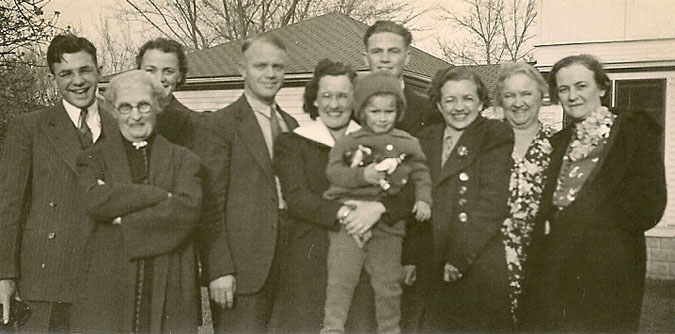 The Hause and Benson lines of the Marchant family meet up during the thirties. From left to right: Henry Benson Jr., Unknown (probably Mary Cattermole [28 Feb 1867 - 1 Jul 1941], a cousin through the Brown family, who lived with the Hauses around 1940), Gretchen Hause (in rear), Carlisle Hause, Margaret Benson Weigelt, Marilyl Weigelt, Carleton Hause (in rear), Alice Benson, and the Marchant sisters, Lillian Marchant Benson and Marjorie Marchant Hause. The Hause and Benson lines of the Marchant family meet up during the thirties. From left to right: Henry Benson Jr., Unknown (probably Mary Cattermole [28 Feb 1867 - 1 Jul 1941], a cousin through the Brown family, who lived with the Hauses around 1940), Gretchen Hause (in rear), Carlisle Hause, Margaret Benson Weigelt, Marilyl Weigelt, Carleton Hause (in rear), Alice Benson, and the Marchant sisters, Lillian Marchant Benson and Marjorie Marchant Hause. |
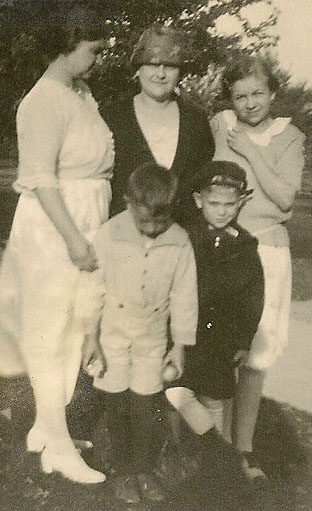
Lillian (left), Marjorie, and children Henry Benson Jr., Carleton Hause, and Alice Benson. |
...Our line was saved from obscurity by GLORIA MARTELL BENSON (31 Aug 1929 - 25 May 2016), whose late husband, Judge HENRY N. BENSON JR. was the son of Lillian Marchant Benson, the sister of my great-grandmother. Gloria provided crucial information to explain how the families of the two sisters had lost touch through the generations: Lillian had died in St. Peter, Minnesota, just a few years after Marjorie Marchant Hause on 12 Aug 1942. She had suffered from diabetes and a heart condition. Her husband Henry Benson Sr. became very ill upon Lillian's death, and her funeral was held in their home so that he could listen to the service from upstairs.
On 25 Oct 1952, their 36-year-old son, Henry Benson Jr., married 23-year-old Gloria Martell (her maiden name was created when her father, born in Minnesota to Swedish immigrants, changed his name from Pierson to Martell while he was in the seminary). They had four children: Julie Elizabeth, Melanie Marchant, Todd Henry Winfield, and Craig Peter—their family owns the Marchant Family Bible and photo albums that hold most of the information and images of the Marchant family in North America that appear on this page.
CHILDREN OF LILLIAN MARCHANT AND HENRY N. BENSON, JR. |
|
ALICE MERLE BENSON was born on 31 Jan 1907 in St Peter, Nicollet, Minnesota. In the 1940 U.S. Federal Census she is a single proofreader working at the Department of Motor Vehicles. She died on 9 Nov 1986 in Spicer, Kandiyohi, Minnesota. She is buried at Woodlawn Cemetery in Saint Peter, Le Sueur County, Minnesota.
|
|
MARGARET LUCILE BENSON was born on 4 Nov 1908 in St. Peter City, Nicollet, Minnesota, and baptized on 17 Jan 1909 in St Peter, Nicollet, Minnesota. She married Walter William Weigelt (27 Dec 1906 - 13 Nov 1966) and they had the following children: Mary Lillian (de los Santos) (b. 1935), John Walter (b. 1946) and William Henry Weigelt (1948-2016). Margaret died on 8 Dec 1993 in Thief River Falls, Pennington, Minnesota and is buried at Greenwood Cemetery in Thief River Falls, Pennington County, Minnesota.
|
|
HENRY NATHANIEL BENSON, JR. was born on 4 Jun 1916 in St. Peter City, Nicollet, Minnesota. On 25 Oct 1952 he married Gloria Elizabeth Martell (31 Aug 1929 - 25 May 2016) and they had the following children: Julie Elizabeth (Italiano) (b. 1953), Melanie Marchant (b. 1955), Todd Henry Winfield (b. 1957) and Craig Peter Benson (b. 1960). Henry Jr. died on 30 Nov 1993 in Spicer, Kandiyohi, Minnesota, and is buried at the Resurrection Cemetery in Saint Peter, Nicollet County, Minnesota, Section D, Row 2, Lot 133, Grave 9.
|
While tracing their roots with genealogist Mark Folkestad, Gloria somewhat miraculously located an earlier, practically empty version of this web page online (just basically a name and a photo or two—all that had been handed down to us), and out of the kindness of her heart contacted our family. So now, the mysterious Marjorie Marchant has a past, and so does my family—and we owe it all to Gloria and our new (to us) cousins.
But... amazingly... the story was not over...
|
L-R: Gloria Benson; Gloria Benson, Craig Benson, and Julie Italiano; Becca Benson, Todd Benson, Rush Benson, Melanie Benson, Brittany Benson, and Gloria Benson.
|

The Benson clan at the funeral of the late, great Gloria Martell Benson in 2016. TOP ROW, L-R: Brittany Benson, Craig Benson, Julie Italiano, Todd Benson, Becca Benson, Peter Yager, Maria Benson; BOTTOM ROW, L-R: Mark Nelson, Melanie Marchant Benson, Rush Benson, Nikko Benson, Ian Cook, Anna Marie Italiano, Dominick Italiano. RIP, Gloria, and THANK YOU forever! |
"I'm looking for a William Marchant (b. 1828), a great great uncle missing from England from 1841 until the 1891 census when he is living with his brother. He's a widower and his death certificate (December 16 1896) quotes his occupation as an army pensioner... As children we loved to see and hold a silver bugle/cornet in a display cabinet but it disappeared after [my grandmother's] death in 1959."
—Message from my newly-found cousin, Paul Harrington.
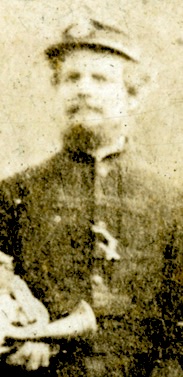
The (then) shadowy figure of William Marchant. |
With the help of Gloria and Mark, this webpage had some Marchant names and photos from the family Bible, and a simple story about a British transplant to Canada named William Marchant, who was called a bandmaster in the Canadian census.
Meanwhile, on the other side of the Atlantic Ocean, yet another long-lost cousin named PAUL HARRINGTON and his first-cousins JULIE CALLANAN and MICHAEL HEALY were researching their Marchant ancestors in Liverpool, Merseyside, England. (This is the point where you start playing the 1965 hit, Ferry Cross The Mersey by Gerry & the Pacemakers). They had started by using Mike's genealogical work with cousins JOE BRIERLEY (sadly now deceased) and JIM McNALLY (also sadly deceased), who had made important family discoveries in the dark days before the internet and online searching. Paul had started a blog site on AOL for first cousins to share memories of the Sarsfield family, while Julie had been researching the Marchants. Paul, Julie and Mike then teamed up to research their common ancestor, ROBERT MARCHANT, JR.
In researching Robert Marchant Jr.'s family, Paul, Julie and Michael were tracing his brother, not coincidentally named William Marchant, who joined the military and traveled to Canada during the 1840's. This William eventually came back to England as a widower (not coincidentally the same time that I lost track of my ancestor in Canada), and he was probably the source of a family mystery: he had been a musician in the army, and the cousins all remembered a bugle that had been handed down through the generations in the family. After doing much research, Paul and his cousins found my website and concluded that their ancestor Robert Jr.'s brother was my 3xGreat-Grandfather, WILLIAM MARCHANT SR.⁹ Paul then contacted me and was able to fill in the Dickensian history of the brothers and several generations of ancestors beyond them.
So, here is the family of my newly-discovered 4th Great-Uncle, Robert Marchant II:
CHILDREN OF ROBERT MARCHANT II AND ELIZABETH LAMBERT |
|
ROBERT JOSEPH "BARNEY" MARCHANT was born in 1867 and was baptized on 15 Sep 1867 at St. Patrick in Liverpool, England. On 12 Feb 1893 he married Margaret Josephine Sarsfield (1868-1937) at St. Augustine in Lancashire, England. Robert and Margaret had the following children: Mary Ann (1894-1917), Robert Thomas (1895-1968), George Patrick (1897-1898), Margaret Josephine (1898-1973), Georgina Ellen (1900-1975), Joseph (1903-1976), Sidney Gabriel (1905-1974), Veronica Magdalene (1907-1910), Kathleen Teresa (1910-1939), and Lawrence A Marchant (1911-1911). At the 1891 census Robert is a dock laborer. By 1901 he is a general laborer living at 84 Healey Street with with his wife and children. In 1911 he is a laborer for a grain merchant living at the same address. Robert Joseph died in 1940 and was buried at Ford Cemetery in Lancashire on 22 Jun 1940.
|
| MARY MARCHANT was born on 22 Dec 1868 in Liverpool and baptized on 27 Dec 1868 at St Patrick in Liverpool, England. On 23 Aug 1891 she married Michael Henry Sarsfield (1867-1938), the brother of Robert Joseph's wife Margaret, at St Augustine in Lancashire, England. The Sarsfields had moved over from Dublin sometime before 1881, and both families lived on the same street in Liverpool at the time of their weddings. Mary and Michael had the following children: Mary (b. 1892), Josephine (1897-1945), Michael Leo (1899-1975), Winifred (1901-1994), Gertrude (1903-1993), Eileen (1905-1993), Patrick (b. 1909) and Nora Sarsfield (1913-2007). Mary died on 30 Jan 1958 and was buried on 3 Feb 1958 at Ford Cemetery, Liverpool, Lancashire, England. |
| GEORGE PATRICK MARCHANT was born on 1 Dec 1870 in Liverpool, Lancashire, England and baptized at St. Augustine's in Liverpool, listed as the son of Robert and Elizabeth (Lambert) Marchant of Clay Street. In the 1891 census, George was a marine fireman (stoker). He emigrated to New Zealand and appears on the Electoral Roll there as a marine fireman first in 1911. He lived in Auckland and married Genevieve Veronica McCabe (1884-1952) there in 1926. He also worked as a river pilot. They had no children but twice wanted to take members of the family from Liverpool to New Zealand. First, Nora Sarsfield when she was a young teenager and then Joe Brierley (son of Gertrude Sarsfield and Joseph Brierley) after Joe's father died. George died in 1948 at the age of 76 in Auckland, New Zealand. |
| HENRY STEPHEN MARCHANT was born on 26 Dec 1872 in Liverpool, and baptized on 5 Jan 1873. He died in 1888 and was buried on 27 Apr 1888 at St Augustine in Liverpool, Lancashire, England. |
| ELISABETH MARCHANT was born on 26 Apr 1874 in Liverpool,and baptized on 10 May 1874 at St Augustine, in Liverpool. She died just three years later, in October of 1877, and was buried on 28 Oct 1877 in Ford Cemetery, Liverpool. |
| THOMAS MARCHANT was born on 4 Apr 1876 in Liverpool. In the 1891 census, Thomas was an unmarried broker's office apprentice. In 1911, Thomas was listed in the census as an unmarried dock labourer working on the Manchester Ship Canal and living in Salford. Family story had it that Thomas lived in Manchester and "had a sweet shop." In the same house as Thomas in 1911 is someone working as a wrapper in a confectionery factory. If he had access to sweets to bring to Liverpool to his nieces and nephews this could have been why he was thought to have a sweet shop. Thomas died in 1957 and was buried on 17 Sep 1957 at Ford Cemetery, Liverpool, Lancashire, England. |
| ELIZABETH MARCHANT was born on 13 Jun 1881 and baptized on 26 Jun 1881 in St Augustine in Liverpool. She died at the age of 14 and was buried on 5 Jan 1896 at Ford Cemetery, Liverpool, Lancashire, England. |
|
| Personal Information |
Census Image |
|
| Name: |
|
Robert Marchant |
| Age: |
|
75 |
| Where born: |
|
Maidstone, Kent, England |
| Civil Parish: |
|
Liverpool |
| Relation to Head: |
|
Father-In-Law |
|
|
|
|
SOURCE INFORMATION: 1901 England Census. "England and Wales Census, 1901," St Martin subdistrict, PRO RG 13, The National Archives, Kew, Surrey.
|
|
The Marchant family then became very close with a family living on the same street in Liverpool, called the Sarsfields. The Sarsfield family had immigrated from Dublin sometime before 1881. Robert's daughter, MARY MARCHANT (1st cousin to my g-g-grandfather, William Henry Marchant), married a MICHAEL SARSFIELD in 1891. The family researchers who contacted me, Paul, Julie, and Michael, are the children of three of their daughters: NORA (1913-2007), EILEEN (1905-1993) and WINIFRED SARSFIELD (1901-1994). Winifred married PHILIP HARRINGTON in 1930, and they had Margaret (1931-2000), Philip (b. 1938-) and the man who originally contacted me, Paul Harrington (b. 1943). He would be my 3rd cousin, 2x removed.
But we still aren't done with the Marchant family, thanks to yet another charitable cousin, MARIE-CLARE AHERN MONK. She is the great-granddaughter of Mary Marchant Sarsfield's brother, ROBERT JOSEPH MARCHANT! He was also known as "Barney" (probably to differentiate him from his father, grandfather and deceased half-brother; there were a lot of Roberts in that household), and he became a dock laborer, like his father. In 1893, Barney married MARGARET SARSFIELD (b. 1868; sister of brother-in-law Michael Sarsfield, husband of Mary Marchant. (Totally confused, yet?) Marie is the granddaughter of one of Robert's children, SIDNEY GABRIEL MARCHANT (17 Feb 1905 - 24 Feb 1974). He married ELLEN REID (11 Jun 1904 - 05 Apr 1982) and they lived their entire lives in Liverpool. Here is their wedding photo:

WEDDING OF SIDNEY MARCHANT AND ELLEN REID. Left to right, back row: Charlie Garrity (cousin of Ellen Reid); Robert Thomas Marchant; Joseph Marchant; Sidney Marchant; Ellen Reid; Robert Joseph Marchant. Front row sitting: James Patrick Reid (Ellen's dad); Kathleen Marchant; Alice Garrity (Ellen's cousin, who lived with them); Georgina Marchant; and Vincent White. Marie-Clare Monk: "Uncle Vin moved to Canada, his family are over there. I met him once when he came over for a holiday, I think I was about 6 at the time. Mum was close to him, and kept in touch. He had a crush on my Grandma when he was young apparently. When she died, she was the last of them all, he said to Mum that there will be one hell of a party going on up there tonight, which I thought was lovely." |
With the times and neighborhoods (and even continents) changing with each generation, the lines of the two siblings lost touch—so although Paul and Marie live near each other, they didn't know each other in real life, and it took considerable genealogical digging to re-establish the link. What amazing times we live in, in which the descendants of Marchant lines ripped apart by poverty and intolerance almost 200 years ago can reconnect from different parts of the world and reunite the family.¹²
Thank you cousin Gloria, thank you cousin Paul, and thank you cousin Marie-Clare!
NOTES ON THIS PAGE
¹—Marriage of Robert Marchant to Sophia Jones on 27 Nov 1825 at All Saints, Maidstone, Kent, England. LDS Indexing Project (Batch) Number: I00535-5 , System Origin: England-EASy, GS Film number: 1835448, Reference ID: p 159, 475. Citation: "England Marriages, 1538-1973," index, FamilySearch, Robert Marchant and Sophia Jones, 27 Nov 1825; citing All Saints, Maidstone, Kent, England, reference p 159, 475; FHL microfilm 1835448.
²—"England, Sussex, Parish Registers, 1538-1910," index, FamilySearch, William Marchant, Christening, Northiam, Northiam, Sussex, England, 29 Jun 1828; citing 00420, West Sussex County Record Office, Chichester; FHL microfilm 1,894,275. Father's Name: Robert Marchant. Mother's Name: Sophia Marchant. GS Film Number: 001894275, Digital Folder Number: 004426949, Image Number: 00420.
³—The Sussex Advertiser of Monday 26 March 1832 reported: "Robert Marchant, 28, for stealing at Brighton, two pounds of pork, the property James Isye." The newspaper noted the decision as, "six months to hard labor in Lewes House of Correction." Punishments were harsh for crimes in the 19th Century. "Thievery" was actually punishable by death! In 1800 there were actually 220 offenses on the statute book punishable by death, then called the Bloody Code. Most of the laws introduced during that period were concerned with the defense of property (which some commentators have interpreted as a form of class suppression of the poor by the rich). Grand larceny was one of the crimes that drew the death penalty; it was defined as the theft of goods worth more than 12 pence, about one-twentieth of the weekly wage for a skilled worker at the time. Crimes such as cutting down trees, stealing livestock—or anything worth more than five shillings (£30 today) could get you the death penalty (in Robert's 1832 case, just stealing pork for your starving family got him six months in prison). As the 18th century proceeded, jurors often deliberately under-assessed the value of stolen goods, in order to avoid a mandatory death sentence. In 1823 the Judgement of Death Act made the death penalty discretionary for all crimes except treason and murder. Gradually during the middle of the nineteenth century, the number of capital offenses was reduced, and by 1861 was down to five. The last execution in the UK took place in 1964, and the death penalty was legally abolished in the following years. But in the time of Robert's birth, there were multiple executions every year on Penenden Heath or Shooter's Hill. The following table from the 1881 book, The History of Maidstone by J. M. Russell, shows the number of prisoners who were sentenced to death at the Kent assizes, and how many of the sentences were actually carried out:
 |
Robert Marchant was "a bit of a lad," as later English descendants would say. There are records in Kent of a Robert Marchant in court for theft at least twice before he would have been twenty years old (there were any number of Robert Marchants living in and around Kent at the time, however). This Robert was even imprisoned once for 12 months. George Marchant, possibly Robert's brother, appears above this Robert in the court record for the latter sentencing, so this could be the two brothers out thieving. George got 18 months to Robert's 12—maybe because he's older, or a re-offender:
| Personal Information |
Criminal Register |
| Name: |
|
Robert
Marchant |
| Date of Trial: |
|
Lent |
| Trial Year: |
|
1822 |
| Location: |
|
Kent, England |
| Crime: |
|
Burglary |
| Sentence: |
|
Acquittal |
| Date of Execution or Release: |
|
No Bill |
|
|
|
| Personal Information |
Criminal Register |
| Name: |
|
Robert
Marchant |
| Date of Trial: |
|
Summer |
| Trial Year: |
|
1822 |
| Location: |
|
Kent, England |
| Crime: |
|
Larceny |
| Sentence: |
|
1 Year |
| Date of Execution or Release: |
|
Imprisonment |
|
|
|
|
|
SOURCE INFORMATION: Criminal Registers, Middlesex and Home Office: England and Wales; Records created or inherited by the Home Office, Ministry of Home Security, and related bodies, Series HO 26 and HO 27; The National Archives of the UK (TNA), Kew, Surrey, England.
|
| Newspaper Article |
File Image |
| Newspaper: |
|
Brighton Guardian |
| Subject: |
|
Police Report |
| Original Publication: |
|
4 March 1832 |
| Subject: |
|
Sophia Marchant arrest |
|
|
|
SOURCE INFORMATION: Brighton Guardian
|
While Robert was in jail, Sophia was not behaving herself, either, as shown in this police report from the Brighton Guardian on the 4th of March in 1832. The broken window that she broke while drunk was at the house of Mr Caudle, a surgeon of Devonshire Place. It appears that she was carrying Mary Ann when she went to court. It states that her husband has been committed on a charge of felony (this was the time that Robert was jailed as a pork thief in Lewes prison). Although Sophia promised the magistrate that she'd go back to Maidstone, we know she went to Lewes (probably to be near Robert), and from there she was sent back to Maidstone with the children.
Robert Sr.'s brother William seemed to court trouble the most of all the brothers (or, at least, he was caught the most). The Maidstone Gazette and Kentish Courier of Tuesday 06 July 1841 reported that 28-year-old William Marchant, lath render, was acquitted of breaking into a building and stealing a dial, two candlesticks, six spoons, and a drinking glass (John Wood alias Thomas Buckwell received 4 months' hard labor; he was the guy that William and Robert helped escape from police in 1837). William wasn't so lucky, however, when the Maidstone Journal and Kentish Advertiser of Tuesday 09 July 1850 reported: "William Marchant, lath-render, 37, (imp..) stealing one silver watch, value four pounds, the property of James Hammond, from his person, at Maidstone. Thomas Belton, receiving the same knowing it to have been stolen.—Mr. Hills was for the prosecution.—Belton pleaded guilty, Marchant was found guilty. There were two other indictments against Belton, which were not proceeded with. Belton, 10 years transportation; Marchant, 12 months hard labour." One has to wonder why the newspapers kept calling William a "lath render"—between prison sentences and workhouse stays, he didn't seem to spend very much time "rending."
⁴—Sophia Marchant Burial Date: 18 Dec 1839. Burial Place: Maidstone, Kent, England. Indexing Project (Batch) Number: I04484-0 , System Origin: England-EASy , GS Film number: 1835449 , Reference ID: 1 252 2013. Citation: "England Deaths and Burials, 1538-1991," index, FamilySearch, Sophia Marchant, 18 Dec 1839; citing, reference 1 252 2013; FHL microfilm 1835449.
⁵—Ingersoll Chronicle & Canadian Dairyman. Thursday, December 23, 1886. Pg: , Col: 6. Date of Event: Friday, December 17, 1886. Text of Notice: "MARCHANT—In Ingersoll, on the 17th inst., Martha L., wife of William Marchant, aged 54 years." (Died on 7 Apr 1872). Death notice (Jan 1859-1872) appeared in the Woodstock Sentinel, 12 Apr 1872, page 2, column 4.
⁶—Ingersoll Chronicle & Canadian Dairyman. Thursday, August 05, 1886. Pg: , Col: 8. Date of Event: Tuesday, August 03, 1886. Text of Notice: "MARCHANT—In Ingersoll, on the 3rd inst., Robert J. Marchant, aged 29 years and 10 months." Appeared in the Sentinel Review, 6 Aug 1886, p. 8, column 3.
⁷—Ingersoll Chronicle & Canadian Dairyman. Thursday, July 10, 1884. Pg: 3, Col: 8. Date of Event: Wednesday, July 09, 1884. Morrey, E. B. weds Marchant, Mary. Ingersoll Chronicle & Canadian Dairyman. Thursday, May 12, 1887. Pg: , Col: 7. Date of Event: Tuesday, May 10, 1887. Text of Notice: "MORREY—In Ingersoll, on the 10th inst., May M. Marchant, wife of E. B. Morrey, and daughter of William Marchant, aged 20 years." According to a compilation of Ontario marriages: "Edward Barker Morrey, 21, book keeper, Ingersoll, Ingersoll, son of James F. and Caroline, married Mary Maria Marchant, 17, Woodstock, Ingersoll, daughter of William W. and Martha L., witnessed by F.T. Morrey and Sarah A. Marchant, both of Ingersoll, 9 July, 1884 at Ingersoll." Also appeared in the Sentinel Review, 18 Jul 1884, p. 4, column 6.
⁸—Email from Genealogist Mark Folkestad, dated 23 Apr 2008: "We've been making progress on tracking the family from her sampler, which Lillian said had been made by 'her Aunt Mary'. Mary Ann Parker, born in 1809 in Cavendish, Vermont, made the sampler in 1822. We don't know if she was blood kin or married into the Marchant line, and with the time involved, she was probably a great-aunt. Mary Ann Parker married Hosea B. Huston and became pioneers in Kalamazoo County. Her older sister Eliza married Thaddeus Smith, and they arrived very early in Kalamazoo County. Their brother John Parker also ended up there. Thaddeus and Eliza Smith had offspring with offspring, so some of that family may be in Michigan still. I haven't been able to track offspring of Hosea and Mary Huston yet. Do these names ring any bells with either of you? We noticed that a researcher who has been indexing Smith birth records in Kalamazoo County was Susan Stahl. Is that, by any chance, the daughter of Gretchen Hause Brundage? Gloria thought it likely. We also had a very helpful reply to our post on Ancestry.com's bulletin board, offering to give us five generations prior to John and Nancy Parker, the parents of the creator of the sampler. I'm hoping that that lady has more recent generations of the family. Regards, Mark"

| "Soldier of the Royal Canadian Rifle Regiment, bet. 1857 and 1862. Reconstitution by Derek FitzJames," from Canadian Military Heritage, Vol. II (1755-1871), Chapter 6. |
|
⁹—E-mail from Paul Harrington: "I'm looking for a William Marchant (b. 1828), a great great uncle missing from England from 1841 until the 1891 census when he is living with his brother. He's a widower and his death certificate (December 16 1896) quotes his occupation as an army pensioner. He is buried in the Church of England section of Anfield Cemetery in Liverpool (238 Priory Road, Anfield, Merseyside England, Postal Code: L4 2SL)." Earlier research on William: "Born 1828/1829 Maidstone (?) to Robert and Sophia (married 1825). With siblings Robert, Mary and maybe Henry and Elizabeth and aunt Rose Balcomb in Coxheath (Maidstone) Workhouse in 1841 census. Re-appears 1891 a widower living with brother Robert and family in Liverpool. Fifty missing years. Robert had been a mariner—did William also go to sea? Join army? prison? or remain a lath render as per family around Kent... I'd better explain our interest in William (the bugler/Music Master). We (three cousins in the UK) are grandchildren through the female lines of Michael Sarsfield and Mary Marchant who married in Liverpool in 1891. Her father was Robert Marchant and we've been able to trace the family back to the mid-18thC. The family is from the Maidstone area of Kent. June 1828 seems to be a good date for Wm's birthday but we have not found a record to substantiate. Another Wm was born in 1828 in Rothfield Sussex but he was born October 5th and baptised November 23rd so it can't be him. Maidstone William's parents were Robert M and Sophia Jones married in November 1825 in Maidstone [our line]. (The Marchants, like many families, keep repeating the same names across the generations so there are Roberts, Williams, Henrys, Marys and Sophias all over the place). I'm in touch with branches of the Ontario genealogical society to see if there's any trace of William after 1886/8. On Martha/Mary's death notice she's designated a married woman not a widow so Wm is still alive. Why no mention of him anywhere in Canada after that time? Robert Marchant (his brother and the eldest child of Rbt and Sophia) had been a sailor and we've traced some of his ships. He had contacts with Canada and somehow, a man called Miles Agar of Newfoundland was in Liverpool in time to be godfather to our grandmother Mary Marchant/Sarsfield. As children we loved to see and hold a silver bugle/cornet she had in a display cabinet but it disappeared after her death in 1959. A family story linked it to the Crimea but I'm very tempted by a bugler coming from Canada. Attached are army discharge records for Wm and the army birth records. Ignore the age and dating of Wm's signing on. It's clear the army fiddled these to show he was the legal age when he started to receive full pay. I have separate records showing he was 3y 3mnths under age when he signed on. I'm trying to chase army pension records to see how Wm was paid (if he did come back to the UK). At 8 pence a day, it wasn't a fortune. (I think that's about 5 cents US money today)." (Paul's e-mail.) Here are army records linking my ancestor, William Henry Marchant (b. 1950), to the soldier William Marchant (b. 1928) that Paul identified in Canada:
| Personal Information |
Canada Returns |
| Name: |
|
William H
Marchant |
| Area: |
|
Canada |
| Birth Year: |
|
1850 |
| Vol: |
|
27 |
| Page: |
|
222 |
|
|
|
| Personal Information |
Niagara Returns |
| Name: |
|
William H Marchant |
| Area: |
|
Niagara |
| Birth Year: |
|
1850 |
| Regt: |
|
100th |
| Vol: |
|
27 |
| Page: |
|
38 |
|
|
|
|
|
SOURCE: Index of Army Returns of Births and Baptisms; National Archives, Bessant Dr, Richmond TW9 4DU, UK; Phone: +44 20 8876 3444.
|
¹⁰—E-mail from Deborah Collins, of Kent Ancestry Research: "There are no other references to the Marchant family in any of the few surviving records for the Maidstone Union for this period (all of which I have transcribed) but this is not surprising as the Minute Book of the Board of Guardians for the early years of the Union mention very few individuals and mainly contain financial matters. When I visited the Maidstone Archives a few days ago I checked the Minute Book for the year 1842 to see if there was a mention of William being assisted to join the army by the Guardians but again found no reference. It may be that it was William's parish which arranged for his enlistment rather than the Union and in William's case this would the parish of Maidstone."
 |
¹¹—William Henry Marchant was lost to our family history until the Kalamazoo Public Library filled in all of the gaps. This great library was organized in 1860 and opened to the general public in 1872. In 2002, it was awarded the prestigious National Library of the Year award by Library Journal. More recently, KPL received a 2011 State History Award for the Local History section of its website, and was honored in 2012 with a Michigan State Librarian's Citation of Excellence Award. It features an excellent research section and genealogy section. You can search the local papers going back over a century here. Phone: 269-553-7873 (www.kpl.gov) Ask for Alexander P. Merrill, Library Assistant, who uncovered all the W. H. Marchant info that the Hause and Benson families had spent decades and decades searching for... in about a minute and a half. More on the William H. Marchant family, recently added online by this great library:
Military Bands of Kalamazoo, by Keith Howard, Kalamazoo Public Library Staff, 2010. Updated March 2012: "The Harmonic Band (occasionally called the 'Harmonica Band,' although they were definitely not playing harminicas) made its debut on the first of August, 1894, during the annual Emancipation Day celebration in Kalamazoo; first sharing parade duties with White's Military Band in the afternoon, and later taking center stage for an evening concert at Turn Verein Hall. By November, the band was able to secure new uniforms and showed them off proudly during a year-end concert at the G.A.R. Hall. (Many of the same musicians joined Joe, Sylvester and Gilmore Phillips of the popular Phillips Brothers' Orchestra and formed the Philharmonic Orchestra, which began performing symphonic music in January.)"
|
|
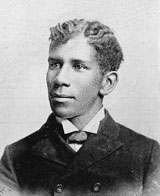
Frank E. Wilson |
|

'Harmonic Band', circa 1894 |
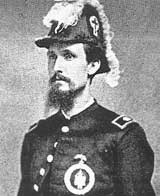
Wallace White |
|
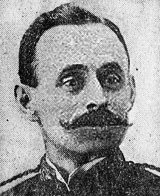
Chester Bronson in 1894 |
| |
Harmonic Band Members (July 1894)
(* Musicians believed to be African American)
- Frank E. Wilson*, manager
- Charles O. Bailiff, secretary and treasurer
- W. H. Marchant, musical director
- Augustus T. Hedgbeth*
- William M. Steward*
- Sylvester F. Liggins*
- Edward J. Harris*
- Gilmore L. Phillips*
- George H. Hill*
- Hiram H. "Hi" Wilson*
- Sylvester C. Phillips*
- Levi D. Bates*
- Joshua W. Phillips*
- Oliver H. "Ollie" Stafford*
- Arthur Wilson*
- Charles H. Hill*
- John T. Pool*
- Jasper Boyd*
Additional members, March 1896 (William H. Marchant Benefit)
- C. Z. Bronson, director
- D. Stuart (possibly Enos Delbert Stewart*)
- S. Scherer
- Charles Pollard*
- Harry Parks*
- T. Stuart (possibly Thomas Stewart*)
Wallace S. White: Kalamazoo Photographer and Bandleader, by Keith Howard, Kalamazoo Public Library Staff, 2009. (Updates and corrections, April 2011): "White also tried his hand at music publishing during this time, by producing sheet music for local composers like Will Marchant." You can also access a photo gallery, with at least one shot of William (in the front row of the military band, shown at right).
Roots of the Kalamazoo Symphony: A Prehistory of the KSO (1881-1921), by Keith Howard, Kalamazoo Public Library Staff, 2010. (Updated May 2013): "Like the Symphony Orchestra before it, the Philharmonic Orchestra didn't last. One of the Philharmonic's final performances was a benefit concert at First Methodist Church on Wednesday, 19 February 1896, in honor of William Marchant, the orchestra's librarian and musical director who was ill... Sadly, Marchant passed away a few weeks later, and aside from a later benefit performance by the 'Harmonica [sic] Orchestra' directed by C.Z. Bronson, no further references to the Philharmonic Orchestra as such are to be found. The Harmonic Brass Band did continue, however, as did the Phillips Brothers' Orchestra, which remained popular well into the first decade of the twentieth century." |
¹²—Another line of the family has appeared: The Philpotts, who are descended from Henry Marchant (1837-1876), who married Mary Jane Brealsford Holness (1838-1862) in June 1857 in Dover, Kent. (This is confirmed through DNA matches, and on the wedding certificate, Henry's father is listed as Robert Marchant, a "lath maker.") So the family line is:
Robert Marchant (1803-1884) > Henry Marchant (1837-1876) > Eliza Brealsford Marchant (1857-1927) > Richard Philpott (1888-1969) > (My new cousins and their descendants!)
One of my new cousins from this line is Jane Butler, MFA: "an artist, designer and lecturer, following a long career in textile and fashion design and lecturing I have returned to drawing, with stitch, a brush, graphite and colour. Colour and a need to find the spirit of the world around me is my driving force. Immersion in research and processes through a Masters in Fine Art have not only honed my skills but also enabled me to dig deeper into areas of philosophy that take my work to new levels of insight. Working with thread as a line, a shadow and a fleeting glimpse of an idea, thought or issue is exciting and rewarding along with sound and light as integral to a viewers experience. I often work with aluminium to reflect and throw back to an observer the colours in light, line and self. My work can be seen in private collections and galleries internationally."
Artists, writers, musicians, dancers... I have to say, I am descended from a very talented family...
IN MEMORIAM |
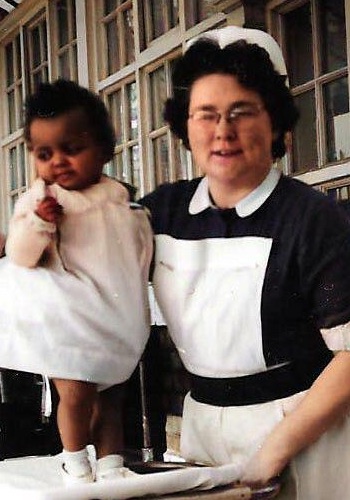 |
Over the last few years I've been meeting a lost line in my ancestry -- the Marchant family of Kent and Liverpool. Now that we've finally reconnected, we've lost a matriarch, VERONICA "RONI" MARCHANT AHERN (1935-2020), to COVID-19. They couldn't have a funeral for Roni with more than 10 mourners, for obvious reasons, but they were able to divert the hearse to drive up to her sister MARIE's home, so that she could at least have some closure. Then everybody in her neighborhood came outside to say so long, applauding as the hearse passed by. Roni's son PATRICK AHERN wrote: "Our mum, Roni, was a strong woman who brought us up to look after ourselves and to look out for others. She was a nurse and Sister at Alder Hey for decades until her retirement. She enjoyed her retirement with dad Chris, her children and grandchildren. Like us all, she missed dad desperately since he died in 2004. She continued to live independently in the house until February 2020 when after some falls she was admitted to Southport General. In late March she contracted COVID19 and died on 6 April. An untimely death and unfair in so many ways. We asked for family flowers only at the burial and any other contributions to Claire House. Mum knew and worked with Claire's mum, Chris Cain, and cherished the difficult work they do." Give here: JUSTGIVING.
|
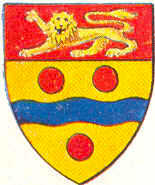 |
| Maidstone |
|
TOP IMAGE: Maidstone Bridge, Kent, circa 1830. Art by William Westall. Maidstone's charter as a town was granted in 1549; although briefly revoked, a new charter in 1551 created the town as a borough. The charter was ratified in 1619 under James I, and the coat of arms was designed, bearing a golden lion and a representation of the river (in heraldic terms: "or, a fess wavy azure between three roundels gules, on a chief gules a leopard passant gardant or"). The River Medway runs through the center of the town, linking it with Rochester and the Thames Estuary. Historically, the river was a source and route for much of the town's trade as the center of the agricultural county of Kent, known as the Garden of England. There is evidence of a settlement in the area dating back to beyond the Stone Age. Saxon charters (c975) show the first recorded instances of the town's name, de maeides stana and maegdan stane, possibly meaning "stone of the maidens" or "stone of the people." The latter meaning may refer to the nearby megalith around which gatherings took place. The name evolved through medestan/meddestane in the Domesday Book with possible variation Mayndenstan, in 1396. The modern name appeared by 1610. It has been suggested that the name derives from stones set into the river to allow clothes to be rinsed in the cleaner water away from the banks. Coxheath, which William's workouse was originally named for, is a village and civil parish within the Borough of Maidstone. (The parish is approximately 2.5 miles south of Maidstone.) The enactment of the new Poor Law in 1834 led to the creation of the "Coxheath Poor Law Union" in 1835, more commonly known simply as the Coxheath Union. This union also involved many of the other local parishes. A reluctant Maidstone was finally coerced into joining in 1836, bringing the number of parishes involved to 15 and leading to the union's name being officially changed to the Maidstone Union (although contemporary references appear to show that the Coxheath Union name remained in general use). The workhouse building later formed Linton Hospital which subsequently closed and the buildings were demolished in the 1990's. The former workhouse chapel remains in use as a parish church for Coxheath. Before it gets too depressing, it should be noted that Coxheath has the distinction of being the original home of the World Custard Pie Throwing Championship, running since 24 June 1967.
COUSINS, COLLABORATORS & CO-CONSPIRATORS... |
|
GLORIA BENSON (31 Aug 1929 - 25 May 2016) was the daughter-in-law of Lillian Marchant Benson, and possessed the Marchant Family Bible from which I derived most of the information about the family of my my great-grandmother, MARJORIE MARCHANT. Gloria married Lillian's son, Judge Henry N. Benson Jr., in Minnesota on October 25, 1952. He was 36 years old and she was 23. Their children are Julie Elizabeth Benson Italiano (Dominick), Melanie Marchant Benson, Todd Henry Winfield Benson, and Craig Peter Benson.
|
|
PAUL HARRINGTON is the great-grandson of William Marchant's brother, Robert. "Robert went to sea (boys from the workhouse often joined the army or the merchant navy). He ended up in Liverpool where he married a Sarah Greenwood in 1854. Their children died in infancy and Sarah died in 1866. Then Robert married Elisabeth Lambert (our great grandmother)." Robert's daughter, Mary, married a Michael Sarsfield in 1891. "We family searchers—cousins Julie (Callanan), Michael and myself—are children of three of their daughters: Nora (1913-2007), Eileen (1905-1993) and Winifred (1901-1994). Winifred married Philip Harrington in 1930, and they had Margaret (1931-2000), Philip (b. 1938-) and myself (b. 1943). By my reckoning that makes my grandmother Mary 1st cousin to William H Marchant; my mother Winifred 2nd cousin to Lillie and Marjorie; and I'm 3rd cousin to Gretchen and Carlton Sr." See Paul with wife Jean by clicking on the photo at right.
|
 |
MARIE-CLARE AHERN MONK: "I am a great, great-granddaughter of Robert Marchant, brother of William. My mother is a Marchant, granddaughter of Robert's son, Robert Joseph Marchant (1867-1940). My grandad, Sidney, was one of six surviving children of Robert Joseph Marchant (number 3)—four more had died. They were very close and very supportive of each other. Robert Joseph was known as 'Barney' apparently; I have a photo of him that I have loved since childhood, he looks like a very happy man, quite a mischievous look in his eye. He married Margaret Sarsfield, sister of Michael Sarsfield who married Mary Marchant. Both families lived on the same street in Liverpool at the time of their wedding. The Sarsfields had moved over from Dublin sometime before 1881, she was born 1868. From what Mum and Auntie Marie say, she was a strong woman too. Those Marchant men must have been good at finding strong women! To be honest, you probably had to be to survive at all, Sophia especially. The Marchants in our line, have stayed in the north of England and spread to the south of England and Canada as far as I know. One of Barney's brother's, George, went to Australia apparently. A grandson of Grandad's sister, Georgina, was a sailor from Canada. He came to visit us and said that he had been in Australia and got talking to a man. He turned out to be a great grandson of George, very small world! I used to live about 10 minutes walk from the cemetery where William is buried. The first house I bought, a little two up two down, was on a side road off Priory Road. I found another co incidence about this house (nothing to do with the Marchants). My father in law is from the south of England, and I was doing some research for him. His dad was from Anfield, and I found a probate notice that said that Jim's great grandad had died in house about 10 up the road from where I lived. There are a lot of houses in Anfield, so he was stunned. Again, a small world."
|
SOURCES:
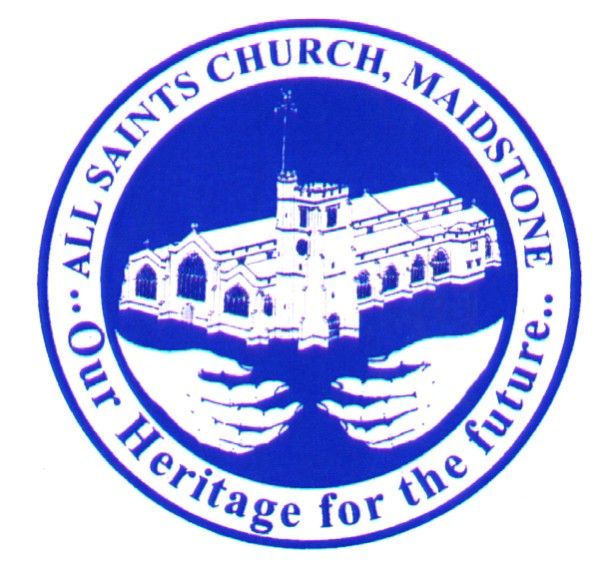 |
All Saints, the Parish Church of Maidstone, has stood commandingly on a cliff by the River Medway in what is now the middle of Maidstone, since about 650. The church was rebuilt in 1381-96 by Archbishop Courtenay in all later English-style architecture as a Kentish ragstone collegiate church attached to the foundation of the College of All Saints; measuring 227 by 91 feet. It comprises the nave, aisles, and chancel, with a chantry of 1366; had formerly another chantry of 1406; has a southwest tower, 78 feet high, formerly surmounted by a spire 80 feet high, which was destroyed by lightning in 1730; contains a richly painted chancel-screen, elaborately ornamented sedilia, the grave of Archbishop Courtenay, remains of an ancient fresco, several ancient monuments, and a Jacobean font; Between 1883 and 1907 All Saints was restored under the direction of the noted Victorian architect John Loughborough Pearson, and fitted with open seats; has a new north memorial window to C. Mercer, erected in 1864; and was collegiate from the 14th-century till the Reformation. Address: Mill Street, Maidstone ME15 6YE.
The Maidstone Museum: "Maidstone offers more than a solitary museum. Though the majority of our 600,000 artefacts can be found in the former Chillington Manor on St Faith's Street, we also operate the renowned Maidstone Carriage Museum and the Queen's Own Royal West Kent Museum. Both museums offer equally compelling collections, and represent popular attractions in the borough of Maidstone."
The History of Maidstone, by J. M. Russell; Maidstone: William S. Vivish, 28 King Street; Frederick Bunyard, 29 Week Street; London: Simpkin, Marshall & Co., 1881.
The History of the Parish Church of All Saints', Maidstone with illustrations, by John Cave-Browne, M.A.; Maidstone: G. Bunyard (Week St.), J. Burgiss Brown (Week St.), and other Maidstone Booksellers; Publication date: 1889.
The Kent Ancestry Research website enables people to solve family history puzzles and to educate about the parish poorhouses and Union Workhouses of Kent.
The Kent Online Parish Clerks: Maidstone Parish website actually lacks a clerk but features area statistics and info, like this Domesday Reference: "Medestan or Meddestane arable, meadow, woodland, a church; five mills and two eel fisheries; 25 villagers, 21 smallholders and 10 serfs; three knights held more arable, meadow, woodland, a mill, two eel fisheries and two salterns [salt-houses], and 32 villagers, 10 smallholders and 10 serfs lived there; value was £35.10s. Principal landholder: Archbishop of Canterbury."
The Kent History and Library Centre is the location of the surviving Maidstone Union records.
The History of Maidstone by J. M. Russell; William S. Vivish, 28, King Street ; Frederick Bunyard, 29, Week Street. London: Simpkin, Marshall & Co., 1881; 423 pages.
British Newspaper Archive: Searching Maidstone and South Kent for 19th Century Marchant news (it's rarely good).
Welcome to St Mary's Church, Northiam: "St. Mary's Church in Northiam is an Anglican church in the Diocese of Chichester and is set in the heart of Northiam village in East Sussex. Although we meet in a beautiful, historic building which dates back to the 12th century, we worship and serve a living Lord and seek to share the good news of his love within our community and beyond."
Sussex Parish Churches: Northiam—St Mary: "The nave, originally aisleless, and tower are C12, though the latter was heightened twice, around 1200 and 1500, the date of the stone spire, which was later altered. Aisles were added around 1300. The east end and Frewen mausoleum are C19. There is good C17 woodwork."
Rough justice—Victorian style, by Peter Jackson, BBC News. Monday, 3 August 2009 14:24 UK
The Workhouse: Maidstone, Kent, Peter Higginbotham's remarkaable site contains information about every facet of the workhouse in the UK.
Crime and Poverty in 19th-Century England: The Economy of Makeshifts, by A.W. Ager. A&C Black, May 20, 2014. Google e-Book. 192 pages.
A Grim Almanac of the Workhouse, by Peter Higginbotham. The History Press (1 Feb 2013) 240 pages.
Extracts from the Diary of a Workhouse Chaplain, by the Rev. D. L. Cousins, A.M. London: J. Hatchard and Son, 187, Piccadilly. 1847.
The Builder, Vol. 32, p.71, 24th January 1874: "A system of rigid classification has been carried out....the several classes in each sex are for aged, able-bodied of good character, and two subdivisions of able-bodied of bad character, together with accommodation for a limited number of boys and girls." (The building later became Lambeth Infirmary/Hospital.)
The Woodstock Museum National Historic Site, which supplied the potrait of William Marchant Sr., and the photo of the 22nd Battalion, strives to interpret the past, present and future through conservation, education and exhibition of local history inside the nationally designated Old Town Hall. Originally constructed in 1853 as the Town Hall and Market House, the building was completely restored in 1993-1995. Admission is Free! Woodstock Museum NHS, City of Woodstock: 466 Dundas Street, Woodstock, ON, N4S 1C4. Thanks to Collection/Exhibit Coordinator Adam Pollard and staff! Phone #519-537-8411 ex. 2902; Fax #519-537-7235
Canadian Campaigns 1860-70, by David Ross and Grant Tyler. Osprey Publishing, 1992. 47 pages.
The Royal Canadian Rifle Regiment, 1840 to 1870, by Major G. Tylden; 'Journal of the Society for Army Historical Research' Vol. 34, No. 138 (June, 1956), pp. 59-62.
The Village That Straddled a Swamp: A History of Woodstock Ontario, by Doug M.Symons; ISBN-13 : 978-0968258309; Published by the Oxford Historical Society; January 1, 1997; 192 pages.
County of Oxford Archives: The Oxford Rifles fonds. (Parallel title COA52) County of Oxford Archives Repository, ca. 1850 - 1989, nd. Created by the Oxford Rifles Militia.
"The Wonderful Message," Publisher: Hartford Music Company, Hartford, Ark. ©1933. Contains the hymn, "Child, Come Home" by W.H. Marchant and C.C. Hall.
History of Nicollet and LeSueur Counties, Minnesota; Their People, Industries and Institutions, Volume II, by Hon. William G. Gresham, Editor-in-Chief; Published by B. F. Bowen & Company, Inc., Indianapolis, Indiana, 1916: Henry N. Benson biography, pages 184-186.
Marjorie Marchant Hause obituary, Mount Clemens Daily Leader, 24 Oct 1939, page 2.
GENEALOGY
THOMAS MARCHANT married MARY and begat...
JOHN MARCHANT (1767 - 1852), who married SARAH REYNOLDS and begat...
ROBERT M MARCHANT (1804 - 1884), who married SOPHIA JONES (d. 1839) and begat...
WILLIAM MARCHANT (1828 - 1896), who married MARTHA LOUISA READ (1832 - 1886) and begat...
WILLIAM HENRY MARCHANT (1850 - 1896), who married MARTHA HOLLAND (1852 - 1911) and begat...
MARJORIE MARCHANT (1892 - 1939) who married CARLISLE HAUSE (1891 - 1972) and begat...
CARLETON MARCHANT HAUSE SR. (1917 - 1983) who married JEANNE MAY BRUNNER (1918 - 2000) and begat...
CARLETON MARCHANT HAUSE JR. (b. 1939) who married MARTHA WENK (b. 1940) and begat...
JEFF (who married LORI ANN DOTSON), KATHY (who married HAL LARSEN), ERIC (who married MARY MOONSAMMY), and MICHELE HAUSE (who married JOHN SCOTT HOUSTON).
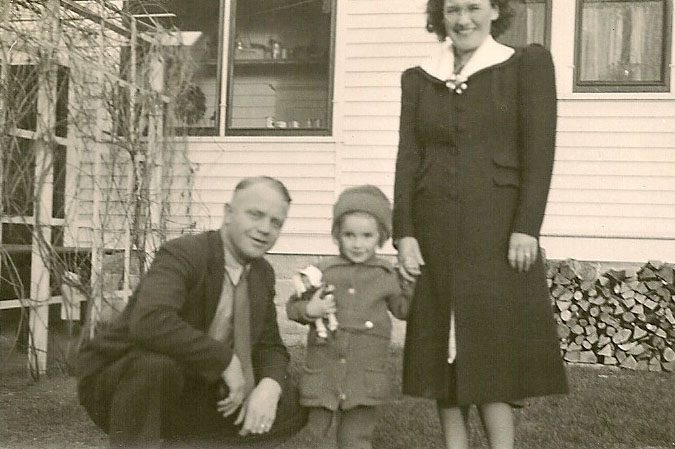
Carlisle Hause with Margaret Benson Weigelt and her daughter, Marilyl Weigelt.
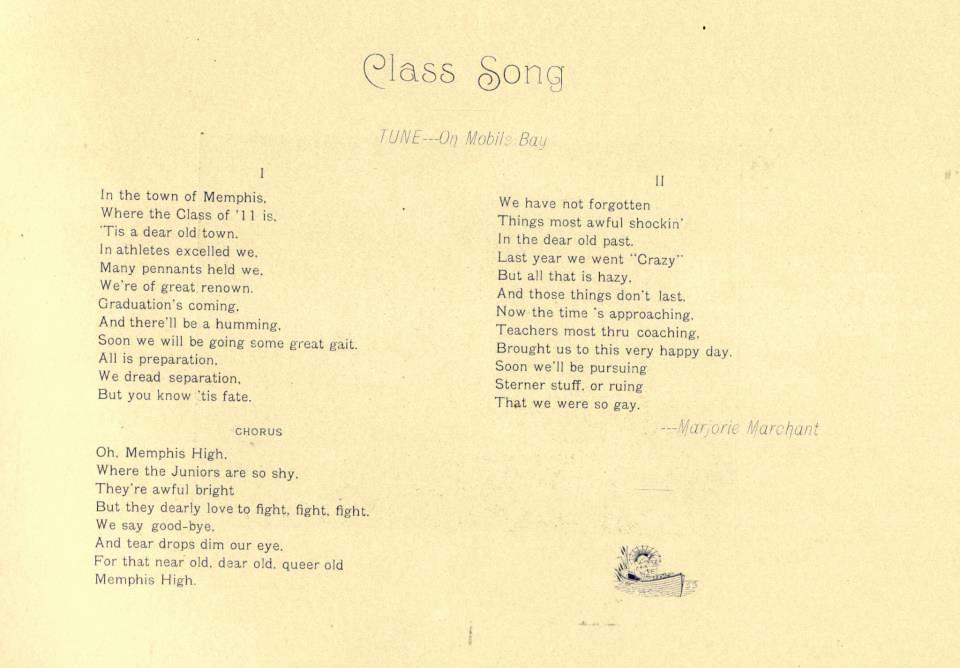
Marjorie Marchant's class song in the 1911 Memphis School Yearbook. (Thanks to Ruth Koppinger Suwalkowski of Memphis for the scan.)
|
 |
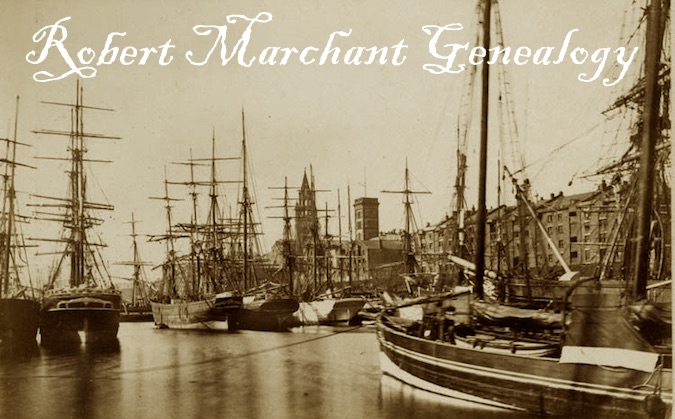 |
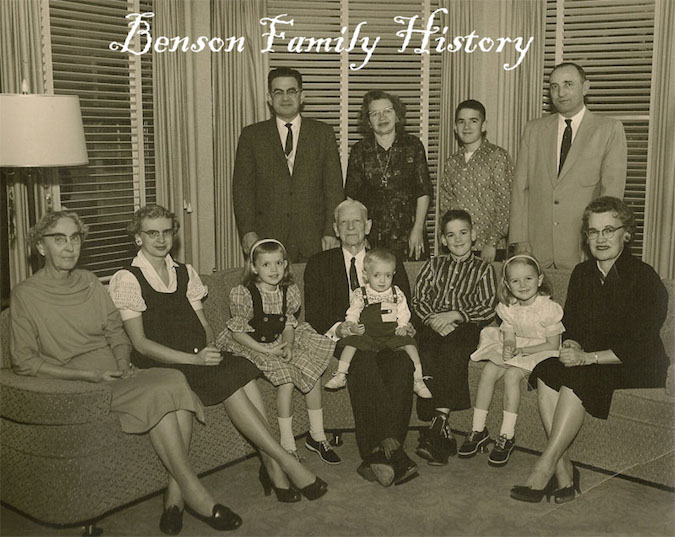 |
 |
|
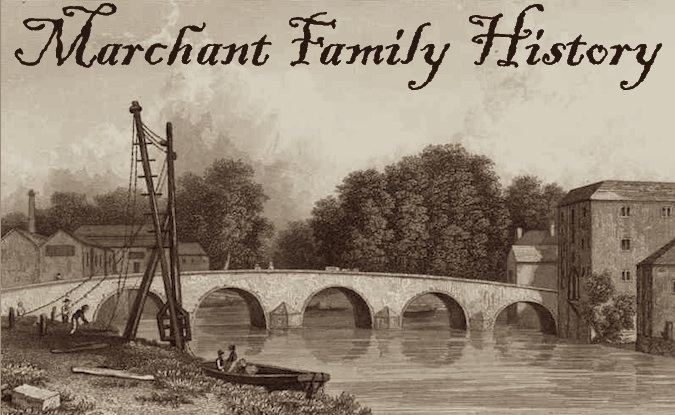



























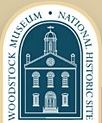









.gif)










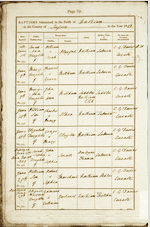


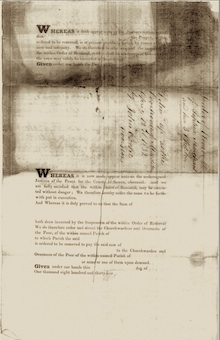
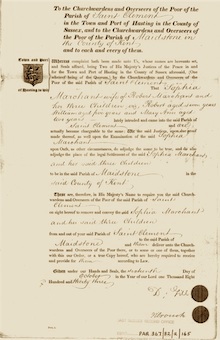

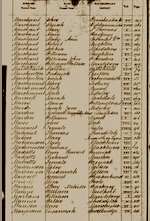


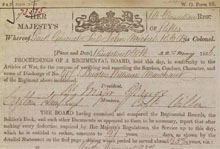
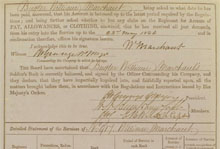
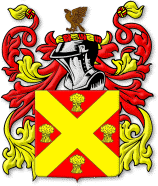




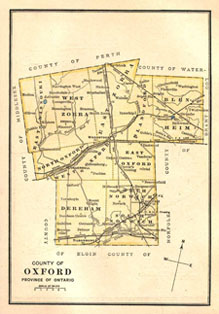
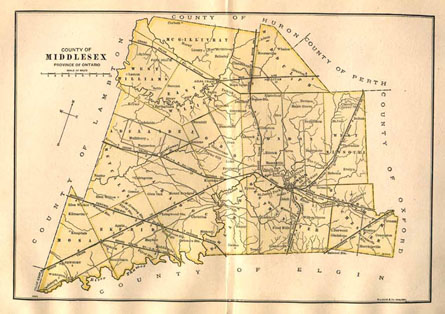


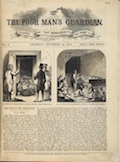

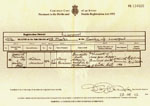
.gif)



